Lachrymae, Chapter IV: The Final Chapter

An Online Journal by Richard Stanley<
(Originally appeared in R. S.' MySpace<, December 9th, 2007.)
Brethren, I have invited you here to this ancient, invisible theatre with the intention of not only unmasking the killer God responsible for these crimes against 'reality', but more cogently, to provide an unambiguous solution to two or perhaps three long running esoteric enigmas!
I salute those who have stayed with the program from the top. For late joiners I include an index to conjure order out of the scrolling chaos and serve as an aid memoir for those hardy few who dare read further. I have very little keyboard time at present and less in the months to come. Until we meet again this strange saga is my gift to you.
Be warned the completed text contains 'spoilers' and may be hazardous to your belief systems.
Chapter Six: She Who Must Be Obeyed
"Oh, Mother! What is God?"
- 12th Century graffiti, Wildenborg Castle
"There it is! Right there on the f*****g wall!"
"What?"
"The f****g spider!"
I steadied the flashlight, its beam picking out a familiar eight-legged outline scrawled on the cave wall above us. Mr. Horn took a half step closer, eyes roaming, taking in the ancient graffiti, the signature of a mysterious vanished cult identical to the markings in the grotto at Tarantula Square. I'm not sure it meant as much to him as it did to me, but I was grateful for his company nonetheless. Mr.Horn, while an expert documentary cameraman, is a man of notoriously few words and as ever his true thoughts remained a mystery to me, his face lost in the shadows.
 The end of the century was in sight and we were deep in the bowels of the Lombrives, the largest limestone cave system in Europe, whose galleries provided a sanctuary to beleagured Neanderthals and emergent cro-magnons alike, sacred to shamans, druids, medieval Christians and heretics in turn. Its myriad tunnels were part of a single conjoined labyrinth, until a glacier sliced the system in half during the last ice age. While part of the system is open to the public with modern spelunkers having penetrated twelve miles or more into its depths, some of the deeper capillaries remain unplumbed to this day.
The end of the century was in sight and we were deep in the bowels of the Lombrives, the largest limestone cave system in Europe, whose galleries provided a sanctuary to beleagured Neanderthals and emergent cro-magnons alike, sacred to shamans, druids, medieval Christians and heretics in turn. Its myriad tunnels were part of a single conjoined labyrinth, until a glacier sliced the system in half during the last ice age. While part of the system is open to the public with modern spelunkers having penetrated twelve miles or more into its depths, some of the deeper capillaries remain unplumbed to this day.
Deep in the heart of mountain lies a subterranean lake, beside whose lightless waters rises a glistening crystalline vault known as the 'Tomb of Pyrene', and identified in popular lore as the last resting place of the bride of Hercules, from whom the mountains of northern Spain and southern France draw their name. Beyond the vast natural column named the 'pillar of Hercules', the passage's ribbed throat widens into a yawning honeycombed wombspace into which Westminster cathedral and Pinewood Studios' fabled 'Bond Stage' could fit with ease, its walls rising into a darkness that our meager lighting budget could never hope to dispel, the dank stone covered in an illegible tangle walls of dead languages, countless scrawled pentagrams and other less familiar geometric markings. Here amidst the dust of centuries, I found the last piece of the puzzle that would complete the cycle begun all those years before in far away Montserrat, the final clue to the identity of the faceless goddess, the 'supernatural' force that had guided my steps and seemingly manipulated the day to day events of my life since the day I had first set foot in the Scala cinema and settled down to the all-day all-nighter that set the long, strange journey in motion...
My first encounter with Our Lady of Darkness had briefly jarred me out of the youthful cynicism I had mistaken for 'reason', but over the years I had somehow pushed the events to the very back of my mind, telling myself it had been little more than a ludicrous chain of 'coincidences', inspired by my overheated imagination and prolonged exposure to Dario's fractured ouvre. What happened at Montsegur in the summer of 1996, however, had proved a whole lot harder to explain away. I tried to tell myself that it had simply been a freak storm, that caught us unawares and that the voltage coursing through the walls of the keep had somewhere affected Kate's brainwaves and triggered the violent seizure that followed. Despite all I had seen, my conscious mind refused to give in to the thought that she had been 'possessed', or that the citadel really was the 'castle of the Holy Grail' after all.
Returning to the Pyreneees, I spent months at a time camped out with Mr.Horn on the holy mountain, locked off cameras covering every conceivable angle, hoping to capture the 'hand of God' and those fiery, plasmic fingers on film for all to see, but we waited in vain.
Our search for the missing Grail historian proved just as fruitless. We followed SS Obersturmfuhrer Otto Wilhelm Rahn's trail back to Germany and pulled every file we could. We found a few survivors, a family, a teddybear, a handful of notes and in the end we had found a grave.
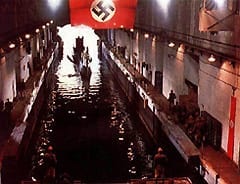
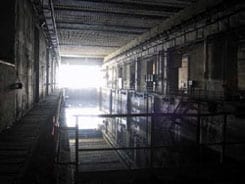
It is not my intention to recapitulate the Rahn affair in this posting, other than to touch upon those aspects that shed some light, inadvertently or otherwise, on the dark domain of Mater Tenebrarum and her siblings. A full account of the sinister saga that lead from the ruins of Montsegur to the ritual chambers of the SS Order Castle in Padeborn and on to the Arctic Circle and an abandoned U-boat pen deep beneath the volcanic crags of the Canary Islands would require a longer and darker night than currently available.
A disc containing some of the interview material generated during the ongoing quest was included as a freebie in last year's Dust Devil box-kit, under the working title The Secret Glory<. Sadly, the discs murky, low-res visuals were further muddled by a soundtrack that wandered wildly out of synch as a result of a half-assed PAL-NTSC transfer, adding one more layer of confusion to an already opaque narrative. Normally, I would have gone apeshit and demanded the disc be withdrawn, but Subversive Cinema had done such a good job with the main feature it seemed churlish to kick up a fuss, especially as their backs were against the wall like every other retailer in the trade. Subsequent events have rendered that weak document wholly obsolete, and while The Secret Glory may stand as a bare-bones introduction to the enigma, it does not reveal the true import of Rahn's work and the bizarre myth complex that surrounds him.
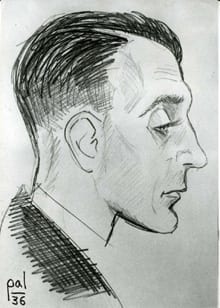 The fact that Otto Rahn existed at all stretches credulity. He seems to have stepped alive from the pages of a 30's pulp, complete with black coat, fedora and those pale-green, oddly otherworldy eyes. Born and raised in the Black Forest, not far from the ruins of Wildenborg, where Wolfram von Eschenbach< first committed Parsifal< to parchment in the 12th century, Otto was a lonely, troubled child. Bullied at school, he sought refuge from his peers and dysfunctional family in the myths of an immutable, vanished past, in the works of his compatriots and role models, the Brothers Grimm and the legends of the knights and troubadours of old.
The fact that Otto Rahn existed at all stretches credulity. He seems to have stepped alive from the pages of a 30's pulp, complete with black coat, fedora and those pale-green, oddly otherworldy eyes. Born and raised in the Black Forest, not far from the ruins of Wildenborg, where Wolfram von Eschenbach< first committed Parsifal< to parchment in the 12th century, Otto was a lonely, troubled child. Bullied at school, he sought refuge from his peers and dysfunctional family in the myths of an immutable, vanished past, in the works of his compatriots and role models, the Brothers Grimm and the legends of the knights and troubadours of old.
Otto's neice insists he was possessed of what she calls the 'seventh sight', and regardless of whether his alleged telepathic abilities were real or imagined, there seems little doubt that he deliberately cultivated an aura of mystery about himself from the very beginning, a suspicion underpinned by his early thwarted ambitions towards a career in the film industry, two surviving unproduced screenplays, and the macabre theatricality of the promotional stills for his first book Crusade Against the Grail (1933).
Inspired by rogue archeologist Heinrich Schliemann's sensational 'discovery' of Troy, the ambitious young philologist set about deconstructing Parsifal in the same manner that Schliemann had approached Homer's Illiad, intending to prove the 12th century Grail romance was anchored in actual historic events.
While still in his early twenties, Rahn was taken under the wing of the mysterious Countess de Pujol Murat, a leading figure in a secret society known as the 'Polaires', who drew their name from Stella Polaris or Arktos, true north symbolized by the swastika, which is said to represent the seasonal positions of Ursa Minor around the Pole Star. To what extent their lodge maintained ties with other societies of its day, such as the Thule Geselschaft, whose leadership were to eventually found the National Socialist German Worker's Party that brought Hitler to power, is hard to tell at this distance in time. While Rahn openly wore the Sieg Rune of the Thule on the sweater knitted for him by his mother, the Polaires themselves seem to have been more closely affiliated to their British counterparts, rather than the racist and increasingly anti-semitic German lodges of their day.
They would later suffer persecution under the Nazis, who suspected the secret societies of either actively aiding and abetting the Jews, or acting as unwitting pawns in a hypothetical 'zionist-Masonic' conspiracy. While the European Polaires were all but wiped out and their records subsequently destroyed in the war, the British movement went from strength to strength, growing out of and eventually breaking away from Conan Doyle's Spiritualist Association of Great Britain (SAGB), under the auspices of charismatic Welsh platform medium Grace Cooke and her ambitious huband, Ivan.
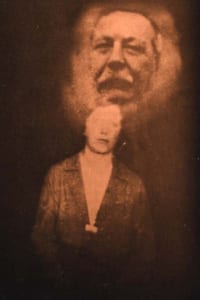 Grace seems to have attempted to wrest control of the SAGB after the demise of its founder and mentor by audaciously channeling his talkative shade in closed sittings with Sir Arthur's bereaved family.
Grace seems to have attempted to wrest control of the SAGB after the demise of its founder and mentor by audaciously channeling his talkative shade in closed sittings with Sir Arthur's bereaved family.
When the Doyle clan began to smell a rat Grace and Ivan split to the Pyrenees, where they spent the better part of the following year as guests of the Countess de Pujol Murat at approximately the same time as Rahn's own sojourn in the south.
The only way to ever know for sure whether Rahn was either a Mason or a card-carrying envoy of the Thule Society, would be to access the surviving British order's records, and to this effect, I took to posing as a clairvoyant at the Spiritualist Association's mouldering West London headquarters, a routine ably abetted by one of the founder members of this virtual tribe, fellow MySpacer and one-time television psychic Andre Phillipe. The White Eagles maintain close ties with the SAGB, recruiting heavily from their hapless membership and accordingly it took me little more than 48 hours to insinuate myself into a gathering of their west London chapter, in a lavishly converted chapel not much more than a block or two from Harrods.
The White Eagles' spotless unisex lab smocks and custom of 'scrubbing down' before and after ceremonies brought the works of David Cronenberg to mind, as much as it recalled the witch cults of Argento's Suspiria< and Inferno<. Certainly it looked as if Cronenberg's resident production designer Carol Spier might have been responsible for the decor, the sparsely furnished interior dominated by a huge swooping Luftwaffe-style eagle that had taken the place of the banished cross. Grace's granddaughter, the orders dynastic high priestess, held court over her devoted following, swathed in turquoise robes, adorned with the distinctive silver star of the Polaires. Despite the exotic, crypto-fascist bling, the essence of her address seemed to be pretty much the same vacuous, feelgood love-thy-neighbour gobbledygook spouted by preachers the world over, so after half an hour or so I politely excused myself, taking the opportunity to avail myself of the small private library and adjoining reading room on the floor below.
Browsing through the order's bound memos and archived copies of their bi-monthly periodical Stella Polaris, it became apparent that any reference to the war years had been assiduously removed. Noticing the high priestesses robed husband, Colm Haywood, watching me with naked suspicion from the reading room doorway, I decided to brazen it out and broach my concerns directly. Colm blanched as I mentioned Otto's name, then recovering his saintly demeanor, he greeted me with a fraternal third degree handshake, assuming that to know as much as I did to connect him with Rahn in the first place meant I had to be 'one of them', and confirming that the Polaires were, in all likelihood, just another franchise of the all-seeing eye. Hastening to set my mind at rest, the high priest explained that earlier editions of the newsletter had been removed for safekeeping to the organizations lavish and closely guarded headquarters in Glastonbury.
Then urging me to get in touch by e-mail should I wish to view the redacted material, he politely showed me the door. I could tell my questions had rattled the high priest or grand wizard or whatever he liked to call himself and it came as little surprise when subsequent attempts to contact him at the address provided drew a blank. The Rahn affair was toxic spiritual waste and the last thing anyone needed was for some smartass to forge a direct, clearly established papertrail, linking Hitler's Reich to the burgeoning New Age movement.
It is impossible to gauge the extent of Rahn's immersion and complicity in the clandestine groups that funded and tacitly guided his early work. Regardless of whether he was a true Nazi, a Masonic fifth columnist or even a closet Zionist, there can be little doubt that the Polaires not only supported and encouraged his research, but deliberately steered his attention towards the heretic fortress of Montsegur, which the young philologist was to subsequently identify with the 'Grail Castle' of song and story. The 'Cathar' castles that dot the Corbieres and the Ariege are the earliest known examples of gothic architecture to be found in Europe and Montsegur, the highest of the citaedels and hence last to fall was said to be the very oldest of them, foundations dating to an earlier epoch lost to us now in the mists of anterior history.

The convoluted 'fourth dimensional' geometric charts drawn by Danielle/Arianne, who had thoughtfully taken to leaving his work pinned to trees and roadside fences in the Rennes area, drew my attention to the similarity between the floorplan of the keep and the constellation of Arcturus, almost the star system's mirror image, inverted as if viewed through an ancient camera obscura. I only wish I had the smarts of the computer power to be able to calculate what those stars might have looked like a thousand years ago when the foundations of the keep were first hewn from the raw stone.
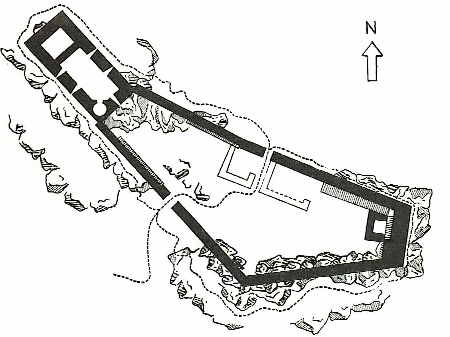
The castle's alignment to the sun, and the subsequent lightshow in the north tower that marks the dawn of every successive solstice, has lead historians and New Age gurus alike to lazily identify the keep's builders with the heliocentric Celts. In point of fact, the building has little or nothing in common with the megaliths of Stonehenge, Avebury or Newgrange. It's construction is without precedent and we have no clue as to its origins, purpose or how it eventually came to be destroyed.
There is every reason to doubt the construction served any conventional defensive purpose. As Jurgen Prochnow puts it in Michael Mann's The Keep< (1983), the whole place is 'constructed backwards', as if to keep something in rather than keep something out. The so-called 'arrow slits' slant inwards and downwards in such a way as to make it impossible to actually fire an arrow through them with any degree of accuracy, and no attempt has been made by conventional archeologists to explain the north facing slit, which communicates not with the outside world but the interior of the keep itself.
A fingertip search of the courtyard, conducted in August 2007, revealed a single area of worked stone, a rough ledge at the base of the north facing slit. No effort has been made by the original architects to otherwise flatten the mountaintop to provide a convenient floor space let alone seats or shelves, yet climbing up onto the ledge I found at once that the narrow shelf was the acoustical focus of the keep, my voice carrying loudly and clearly throughout the edifice.
It is my considered opinion that the mysterious, almost vaginal slit in the north tower is aligned to the position of the moon at the spring equinox (the anniversary of the fall of the castle - March 15th 1244), just as the east facing slits are designed to harness and concentrate the first, faint light of the solstice dawn. This apparent alignment to both the moon and the stars dispells the notion of any simple heliocentric culture having been at work, hinting at a far more complex understanding of the physical universe. In fact, what the castle resembles more than anything else is a vast pinhole camera...
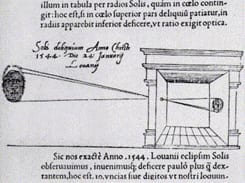
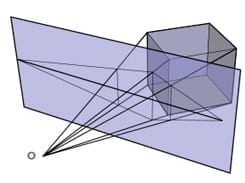
(Left:) Graphic representation of a pinhole camera. (Right:) Rays of light travel from the object, through the picture plane, and to the viewer's eye. This is the basis for graphical perspective.
The history of the motion picture apparatus has long been intertwined with the 'dark art' of sorcery. The gimmick that ate the medium. A cheap conjurors trick, that eventually took over the auditorium and forced out the human performers.
Stage magician George Melies was the first to grasp the camera's capacity to lie after licensing the first projector from the Lumiere Brothers, who drew inspiration from Roget's famous pamphlet on fusion frequency, which was in turn derived from the zoetrope or moving picture wheel, a toy of the devil shunned for centuries by the Catholic church, who, like the modern day Taliban, deemed its capacity to mimic the 'illusion of life' inherently heretical...
The magic lantern enters the history books with Giovanbattista Della Porta's experiments in light and shadow, using a device described as a 'thaumaturgic' in the Magiae Naturalis, probably the same early form of motion picture projector as the Lucernae Magicae seu Thaumaturgae, described by the Jesuit monk Kircher in the second edition of his Arsmagna Lucis et Umbrae.
Kircher's work influenced the creation of the henakitoscope (1832), the zoetrope (1860), the kinemetoscope (1861), the kineograph (1861), and the praxinoscope (1877) and finally Thomas Alva Edison's kinetoscope (1899). Edison had a pet name for the tar-papered studio in West Orange, NJ, where all his prototypical films were made. He called it the 'Black Maria' - a term richly, if inadvertently, redolent of the image to whom Inago de Loyola, the founder of the Jesuits, dedicated his life in 1522, the Black Madonna of Montserrat...
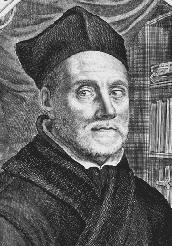
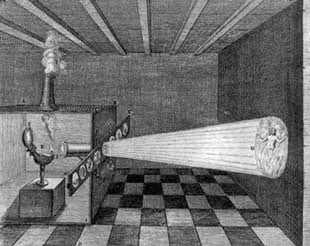
(Left:) Rogue Jesuit Athanasius Kircher (Right:) "The third key is beneath the soles of your shoes" - A plate from the Arsmagna betrays not only the origins of the cinematic apparatus but a funky taste in chessboard floors - a form of esoteric shorthand that should be instantly apparent by now even to the untrained eye.
Kircher wrote his treatise in 1646, but it is generally conceded that the device was in use long before its closely guarded secret appeared in print...
The famous Italian goldsmith, Cellini, recorded in detail his meeting with a notorious Sicilian magus during his visit to Rome in 1540. While discussing the 'magical arts' with the sorceror, Cellini remarked that he would like to see someone invoke demons, and the older man calmly offered to produce a horde of them for his benefit. The ruins of the Colosseum were chosen by the magus as a suitable spot for such a demonstration and Cellini arranged to meet him there the following evening, bringing along one of his friends to act as a credible witness. Within the silence of the vast amphitheatre, the necromancer drew circles in the dust and kindled a fire upon which he tossed various substances that produced a dense column of perfumed smoke. He then began a lengthy incantation, while there appeared about the circle a vast array of devils, which, according to Cellini, completely filled the Colosseum. The sorceror called the demons by name while Cellini's friend shook with fear, pointing out four gigantic devils in full armour, who seemed to be riding across the walls of the ancient auditorium. In an effort to reassure the trembling onlookers, the magus told them the demons were in fact only smoke and shadows. Indeed, they gradually diminished in number, their outlines fading from view as the smoke cleared...
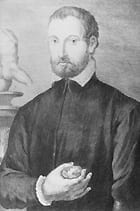
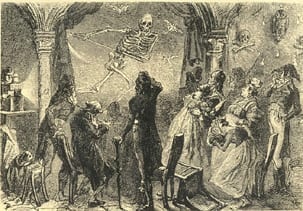
While some sceptics dismiss Cellini's account as pure fiction, it seems more probable the author is simply exagerating an actual experience, as was his custom throughout the autobiography. From the given account, it seems the Sicillian warlock was using a mechanical device, possibly operated by hidden accomplices to achieve the ghostly illusion. This sort of skullduggery dates back to ancient times, when concave metal mirrors were used in pagan temples to project brilliant lights and even images upon various surfaces including smoke, a theory supported by British historian and archeologist Sir David Brewster. The smoke from the fire may have caught occasional images, but the mighty background of the Colosseum itself is the only sure solution to the mystifying effect, otherwise the sorceror would surely have chosen some other, more convenient venue. The name of the thaumaturge mentioned in Cellini's account has sadly not come down to us, but his Sicillian origins bring to mind the order of the 'Faithful in Love' described by Dante, that allegedly traced its roots all the way back to 12th century 'Cathar' prophet Nicetas himself.
In his thought-provoking novel Flicker (1992), Theodore Roszak speculates on how the 'moving picture wheel' may owe its ancestry to the flick books of the gnostics, apparently designed to demonstrate to the initiate how life as we know it is itself merely an illusion created by a constant subatomic flicker, a friction between positive and negative charges, between existence and non-existence, between spirit and matter, light and darkness...
There seems little doubt that the Albigensians of the 12th and 13th century were an oddly civilized folk for their day with fragmentary records referring to a 'Jewish school of medicine' in Toulouse and a 'school of magic' in Salamanca. They had a form of proto-democracy in the form of elected 'magistrates', or 'capitouls', who acted as a check on the power of the church and the aristocracy and, while not essentially matriarchal as some have claimed, were at least unusually egalitarian in their gender politics. Some say they were Luciferians like the Yezzidis, others that they were the last of the true Christians but in the end it doesn't matter who they really were or why they fought or why they died. To quote Conan The Barbarian<: "All that matters is few stood against many", and as I learned the facts of their history, I couldn't help but feel a growing affininity with the castle's stubborn defenders, just as I had been drawn to the plight of the beleagured Kafirs of the Hindu Kush.
At first I knew little more than what I had gleaned from the script of 'La Chiesa', but there was something about the high, wooded valleys and dim-blue mountaintops that reminded me of Afghanistan and stirred feelings I couldn't adequately explain. In South Africa, the Afrikaners called black people 'kafirs' (the word used by the Arab slavers for those, who did not believe in Islam and hence could be bought or sold like cattle. It was a 'fight word', an insult like 'nigger', and I felt a natural, intuitive abhorrence for the Apartheid system that alienated me from my family and birth place from the very top...).
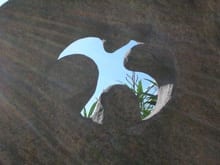 In Afghanistan, I was moved by the plight of the 'kafirs', the pagan tribal folk of 'Kafiristan' - the land of the heathens, and was opposed to both communist atheism and militant Islam. The word 'cathar' was used an insult by the Teutonic knights and crusaders who took Occitania by force. It too is a 'fight word', not a belief system. It is in fact the same word by another spelling. A heretic. An unbeliever. Someone who does not bear allegiance to the one God, be it Mohammed or Jehovah.
In Afghanistan, I was moved by the plight of the 'kafirs', the pagan tribal folk of 'Kafiristan' - the land of the heathens, and was opposed to both communist atheism and militant Islam. The word 'cathar' was used an insult by the Teutonic knights and crusaders who took Occitania by force. It too is a 'fight word', not a belief system. It is in fact the same word by another spelling. A heretic. An unbeliever. Someone who does not bear allegiance to the one God, be it Mohammed or Jehovah.
The basic principals of the dualist heresy should be well-known by now to long term readers of this blog. In short, the difference of opinion that sparked the third and last crusade, springs from the simple notion that infinite goodness cannot create evil. Since there is evil in the world, it follows that some other principal must be at work. The conventional monotheisms put this down to God's plan, but while pain might enoble man, as William Peter Blatty rightly points out, "does pain enoble a caterpillar?" Children and animals are innocent. Why should they suffer and die?
The creator of this world (God/ Yaweh/ Jehovah/ Allah/ what you will) either doesn't exist, or is quite evidently insane and does not necessarily love us nor mean the best for us. Although this force has the power to torture our physical bodies and even kill us when necessary, it has no power over our immortal souls, which the 'Cathars' believed were created by the true, good God and were apparently eternal. Needless to say, this idea held great appeal in the middle ages when life was by all accounts nasty, brutish and short. In order to hide the evil in this world, the 'Cathar' holy men or 'parfaits' believed an illusory veil had been drawn over our eyes.
Each of us however is supposed to have a divine counterpart, unfallen akin to a 'guardian angel' or Socrates' 'daemon', who is trying to help us awaken. This other personality is the authentic waking self. The one we have now is asleep and minor. We are in fact asleep and in the hands of a dangerous black magician disguised as the True Good God. The bleakness, the evil and pain in this world causes us to fall asleep into delusion early in life. Like Keanu Reeves, we really do have superpowers but can't remember how to use 'em. The act of awakening, of slowly becoming aware of these powers, is not so much an act of learning as an act of 'anamnesis', of remembering which implies there must be something to remember and that our actual lives extend beyond our apparent births and deaths.

Yet this malign force, which deliberately manipulates and misleads us (known as 'Rex Mundi' or 'the king of the Earth' to the 'Cathari'), cannot be infallible, otherwise you wouldn't be reading this blog in the first place. The all-seeing eye is not all-powerful, but tries to deceive the children of the kingdom into believing so. And if the designer of the prison programme is fallible, then it can be beaten. That is the true meaning of the first law of magic; 'As above, so below... 'Gods' are only enlightened 'mortals', hence mortals might, through the piecing together of seemingly dissociated information symbolically encoded in our minds over successive generations, regain the key to their secret.
Christ (like the prophet Elijah) is said to have 'entered alive into the Kingdom of Heaven'. Possibly other ascended masters are rumored to have existed over the centuries. Maybe we can make it to the next level, but it ain't easy as Gilgamesh found out. We are nothing more than an energy wave, a frequency after all. Maybe it's possible to change channels? The last time anyone seems to have pulled this off was when Fulcanelli, the master alchemist, is supposed to have transcended the fabric of space time at some point just before or during the Second World War, having apparently unpicked the 'art of light' encoded in the gothic architecture of the great cathedrals and mansions of Europe. According to his principle disciple, the publisher Eugene Canseliet, Fulcanelli had been aging backwards for some years and seemingly changed gender before disappearing. Farfetched, I know, but I have not been able to satisfactorily dismiss the possibility. All I know is he isn't really hiding beneath the floorboards as Leigh McClosky discovered in Inferno.
The trouble with these so-called 'ascended masters' is that there never seems to be one around when you need them. While prepared to keep an open mind on the subject, my attempts to track them down and better still, obtain an interview have thus far proven, well... a li'l disappointing.
When I first heard of Otto Rahn, I was told by Marius Mounie, the former mayor, that the celebrated Nazi Grail historian was alive and still visited the castle regularly, which jived with the notion that he had found the Holy Grail and attained some form of immortality after all. A cursory search of the records in his home town, however, revealed a surviving family, a death certificate and a grave in short order. Only a DNA test could tell for sure whether it was really Otto in the grave, but the brutal logic of Occam's razor would tend to indicate that the man is dead and not still swanning about the Pyrenees on some fourth dimensional etheric sabattical.
It was a typically grey day in Darmstadt. I stood at the foot of Otto's grave thinking it through. In the end, I left him twelve red roses and the blackbird feather from the cave I'd been wearing in the brim of my hat before turning away and getting on with my life.
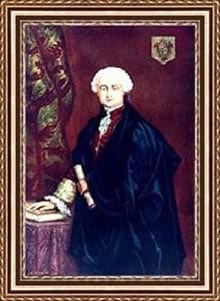 Time and the limitations of the medium prevent a full discussion of the life of the Count Rakoczy, also know as the Count St. Germain, a flamboyant Transylvanian diplomat, freemason and alchemical dabbler, who was said to have invented a patent diamond-making process in addition to having obtained the Great Work and hence the secret of immortality. He wore diamond buttons on his frock coat and once presented Princess Catherine of Russia with an artificial gemstone the size of an ostrich egg, but history does record that he died in his late sixties in Schleswig, Germany. He was interred in 1779 in the local graveyard at Eckenforde, and while I'm familiar with the usual argument that he somehow faked his own death and survives to this day, the inscription on his headstone seems unequivocal: "He who called himself the Comte de Saint-Germain and welldone of whom there is no other information, has been buried in this church."
Time and the limitations of the medium prevent a full discussion of the life of the Count Rakoczy, also know as the Count St. Germain, a flamboyant Transylvanian diplomat, freemason and alchemical dabbler, who was said to have invented a patent diamond-making process in addition to having obtained the Great Work and hence the secret of immortality. He wore diamond buttons on his frock coat and once presented Princess Catherine of Russia with an artificial gemstone the size of an ostrich egg, but history does record that he died in his late sixties in Schleswig, Germany. He was interred in 1779 in the local graveyard at Eckenforde, and while I'm familiar with the usual argument that he somehow faked his own death and survives to this day, the inscription on his headstone seems unequivocal: "He who called himself the Comte de Saint-Germain and welldone of whom there is no other information, has been buried in this church."
And so to 'Fulcanelli' - the author of The Mystery of the Cathedrals, and the last on this short, distressing list of ascended adepts and modern masters...
The work of Patrick Riviere, among others, dovetails with my own making it abundantly clear that the master alchemist was none other than the eminent French physicist Jules Violle, a member of the Academy of Sciences and inventor of the calorimeter. While undoubtedly a genius, he would appear nonetheless to be a dead genius, having apparently passed in his home town, the tiny village of Fixin on September 12th, 1923, at the age of 83.
Of course, there are a few irregularities surounding his demise. His son, Henri, signed the death certificate, rather than the local coroner, and I am fully aware of his pupil Eugene Canseliet's long-standing claim of having met the master years later in Seville, where he is meant to live and work to this day, an ageless alchemical hermaphrodite operating out of a ghostly manor that cannot be found on any earthly map, existing seemingly in a fold in space-time.
The thorny matter of immortality, aside the unmasking of the master alchemist, raises more than a few cogent questions. The name 'Violle' immediately brings to mind the name 'Varelli', given to Fulcanelli's surrogate in Argento's Inferno (1980). While the spelling may differ, the names essentially sound the same in keeping with the rules of Fulcanelli's beloved 'phonetic cabbalah', yet it goes without saying il mastro denies any conscious knowledge of this apparent 'coincidence'.
A split second after Leigh McClosky tears up the floorboards of his sister's apartment in the last reel of Inferno, a cat leaps abruptly through the open window and then disappears into the newly opened hole in the floor, while the Keith Emerson -score goes ga-ga on the soundtrack, signifying not only that we have found the alchemist's, and hence the Black Mother's hiding place, but oddly recalling a similar moment in Poe's The Black Cat, which Argento was to later adept for television, a matter detailed at some length in the first installment of this running saga. Quickwitted readers may also recall that this was the title given to Daria Nicolodi's illegitimate attempt to complete the trilogy with director Luigi Cozzi at the helm - The Black Cat<, aka Dei Profundis (1990).
"What secret could possibly lurk between these soundly put together walls?"
What secret indeed ?

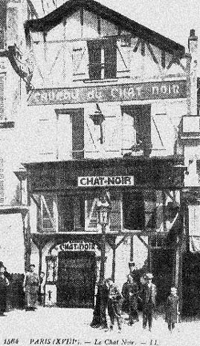
In so-called 'real' life, Jules Violle could be commonly found in his favourite drinking hole - the Parisian 'Cabaret du Chat-Noir' or 'Black Cat Club', which he warmly describes in the second volume of his trilogy The Houses of the Philosophers (1929):
Many of us remember the celebrated Chat-Noir... but how many knew of the esoteric and political centre that was concealed there, of the international masonry that was hidden behind the signboard of the artistic cabaret. On the one hand, the talent of fervent, idealistic youth made up of carefree, blind aesthetes in search of glory and incapable of suspicion; on the other hand, the confidence of a mysterious science mixed with obscure diplomacy - a dual faced picture deliberately exhibited in a medieval frame...
The 'Caberet du chat Noir' was the home of the notorious anarcho-esoteric theatre company - 'Le Theatre d' Ombres', better known to us now as 'The Shadow Theatre', and whose first production at the Black Cat Club was a little confection entitled The Temptation of Saint Anthony - a cracking show by all accounts and yet another 'coincidence' in the endless spiral of maddening synchronicity. Perhaps as Kazanian, the aleurophobic book seller in Inferno so baldly and simply states: "The only true mystery is that our very lives are governed by dead people..."
Some believe that Fulcanelli, like the true Christ, the Cathar parfaits, Lovecraft's 'old ones', or the 'secret masters of the world' is really still alive after all on some other unreachable channel, influencing our affairs with seemingly magical powers, communicating with us in dreams, backward masking, lattices of 'coincidence', glitches in the matrix. Call 'em what you will...
Fulcanelli said: "For an initiate to become an adept he must climb an 'analogic' ladder of correspondences." Or as Agent Cooper puts it in Twin Peaks<: "When two things happen at once, you should always pay strict attention," although strangely it is our nature to disregard these moments or discard them just as we forget our dreams. In this way the 'matrix' defends itself. Consensus reality seamlessly rebuilds itself anew and we willingly fall asleep into delusion, willing jailors in our own living prison cells.
The earth is a bridge. We stand on a causeway between worlds, are judged according to which power we give allegiance to. We cannot understand what the creator's plans are for us, or what will happen once we cross the bridge...
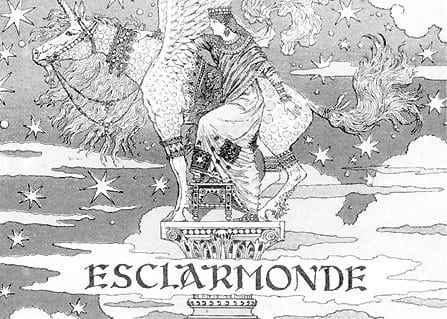
The 'Cathars' were typically stigmatized as 'devil worshippers' by Pope Innocent III, who called a crusade against them in the 12th century. It was a war of extermination that claimed some eight million lives. By the time the dust settled, the kingdom of Occitania had been wiped from the map and its language, Romans, a form of Anglo-Saxon similar to English, that came to be known to later historians as 'Occitan', passed into oblivion along with the tarnished ideals of chivalry. I suspect the kings of France were motivated more by greed than anything else, by the desire to possess the fertile lands and the notoriously beautiful daughters of the south. A psychological band-aid to help boost morale after the shock of losing Jerusalem to the Moors, just as the US had to wage war on Iraq to make up for the trauma of 9/11. The powers that were had to poison a couple of Popes to get their way and lacking the mechanization of the Nazis, it took them more than a generation to achieve their aims.
The last stand of the Cathars took place at Montsegur, literally the safe or 'secure' mountain. The siege lasted two years and there were battles and skirmishes fought every day.
Many of the great heroes of chivalry fought and died there. "Men such as Lantar, Belissen and Caraman", according to Magre and the mesmerisingly beautiful Esclarmonde d'Alion, also known as "Esclarmonde the Bastard", swordsmistress of the south, who fought beside her twin brother Loup. Through two winters the defenders of Montsegur held out against the Pope, against the Spanish inquisition, the Teutonic knights, the kings of France and Simon de Montfort - founder of the British bicameral parliamentary system, effectively against the world.
The castle fell to treachery just before the spring equinox in the second year of the siege, when shepherds from the neighboring village of Camon showed the Teutonic knights, who were accustomed to the icy Alpine conditions, the secret path up the sheer side of the mountain by which the defenders smuggled in their supplies and on March 16th, the last of the Albigensians, some 225 surviving men, women and children were dragged down the mountain in chains to perish on the Camp de Cremat.
The events of the last crusade were suppressed by successive chroniclers, who all too readily took their lead from the inquisitors. The castle's history as, above all, a symbol of resistance made it impossible for the conquering orthodoxy to Christianize or take into the Holy Roman faith as they did at Montserrat and countless other pagan sites such as Montserrat, Lourdes or Fatima.
Ashamed of their ancestor's genocidal history, it is hardly surprising that the French film industry has thus far avoided the subject matter and the outside world has little interest in what it considers to be a quirk of 'French history'. When the 'Cathars' do surface in films, they are usually portrayed in the inquisitions terms as fanatics or devil worshippers...
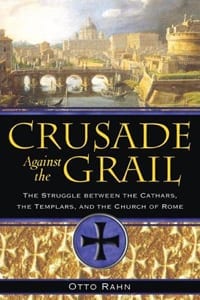 Otto Rahn's account, Crusade Against the Grail, was the first to be published outside France, and no mention of Occitania and its vanished tongue was made in the English language until 1940. Despite the title, surprisingly little reference to the Grail itself is made in Otto's opus. Like the Moors, the 'Cathari' admitted to the existence of Christ, but their evident disdain for the material world is at odds with the Catholic veneration of earthly relics, such as the folkloric Cup of the Last Supper. Besides, as aforementioned, nobody seems to know what a Grail is, let alone who the damn thing belongs to. Theories range from the sacred bloodline or 'Sangraal' described in Baigent, Lincoln and Leigh's fanciful bestseller The Holy Blood and the Holy Grail, Bran's cauldron, the lost Gospel of Saint John, the Book of Nicetas, a graven tablet or a 'hard, dark stone', symbolic of Christ's suffering according to Wolfram von Eschenbach's Parsifal.
Otto Rahn's account, Crusade Against the Grail, was the first to be published outside France, and no mention of Occitania and its vanished tongue was made in the English language until 1940. Despite the title, surprisingly little reference to the Grail itself is made in Otto's opus. Like the Moors, the 'Cathari' admitted to the existence of Christ, but their evident disdain for the material world is at odds with the Catholic veneration of earthly relics, such as the folkloric Cup of the Last Supper. Besides, as aforementioned, nobody seems to know what a Grail is, let alone who the damn thing belongs to. Theories range from the sacred bloodline or 'Sangraal' described in Baigent, Lincoln and Leigh's fanciful bestseller The Holy Blood and the Holy Grail, Bran's cauldron, the lost Gospel of Saint John, the Book of Nicetas, a graven tablet or a 'hard, dark stone', symbolic of Christ's suffering according to Wolfram von Eschenbach's Parsifal.
Rahn identifies the Grail with the 'Crown of Lucifer', that fell from the peacock angels brow when he was cast out of heaven. The diadem fell to Earth in the Hindu Kush, where it was carved by master Afghan craftsmen into the cup used by Salem to consecrate the temple Abraham, built in Ur of the Chaldees and eventually borne back to Europe after those pesky Romans looted the Holy of Holies. According to Otto, the servants of Lucifer still seek their master's lost diadem so that he might regain his rightful place in the kingdom of heaven. Searching from one lifetime to the next, down through the ages...
Legend has it that the Cathars counted the Grail amongst their treasures, but just before the forces of darkness entered the castle, a dove descended from on high and split the mountain with its beak. Esclarmonde hid the cup within the solid rock before turning into a dove herself and ascending into the kingdom of heaven. Others believe the treasure was smuggled out by a small group, who escaped by ropes down the sheer side of the mountain the night before the castle fell, and were hunted like animals by troops acting under the Seneschal of Toulouse, who had drafted in packs of bloodhounds expressly for this purpose.
One band under Esclarmonde d'Alion was cornered in a cave on the banks of the icy Ariege and buried alive by their pursuers, who did not dare to follow them into the labyrinthine tunnels in which they had taken refuge. Instead, the crusaders sealed the cavern and pitched camp, standing guard until all signs of life from within the mountain had ceased. Then they struck camp, saddled their horses and rode away leaving behind them a rampart of stones that remained untouched for seven centuries.
Despite the emphasis placed on the Grail's essentially spiritual nature, a reminder that it is our sacred duty to strive towards perfection, there is a disturbing literalness to Rahn's quest - a pragmatic, methodical, typically German approach to the mystery.
After his attempts to buy land in Montsegur itself were thwarted, he moved to the nearby valley of Ussat, concentrating his efforts on the ruins of Lordat and the caverns of the Lombrives. A news item from a 1933 edition of the local newpaper La Depeche, headed "Gold Rush in the Pyrenees", puts it succinctly:
An international secret society known as the 'Polaires' are digging up the foundations of the ruined castle of Lordat under the command of a shadowy German individual named Rams.
An amused letter from Otto himself appeared in the subsequent issue.
My dear sir, you are entirely mistaken! My named is Rahn, not 'Rams'!
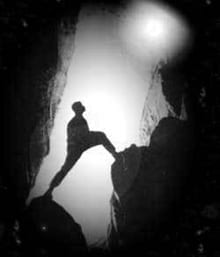 In order to continue his increasingly obsessive investigations, Otto negotiated the purchase of a small hotel near the mouth of the largest cave and equipped it with a dark room in order to process the hundreds of photographs taken during the course of his work, which included extensive analysis of the graffiti found on the walls of the subterranean galleries, that honeycomb the escarpments above the Ariege. Stories of this period are far too numerous to innumerate, Rahn's establishment, 'Des Maronniers', providing the focus for a convoluted web of local legends. Its patrons were said to include the emissaries of countless obscure lodges and vanished secret societies, fancy women from Toulouse and Paris, English psychics, Basque, Occitan and Catalan nationalists, Italian fascists and German fifth columnists including Karl Wolf, who was later to become personal adjutant to SS Reichsfuhrer Heinrich Himmler<, the historian Isabelle Sandy, Dr. Laffont and the mysterious Mr. Baby.
In order to continue his increasingly obsessive investigations, Otto negotiated the purchase of a small hotel near the mouth of the largest cave and equipped it with a dark room in order to process the hundreds of photographs taken during the course of his work, which included extensive analysis of the graffiti found on the walls of the subterranean galleries, that honeycomb the escarpments above the Ariege. Stories of this period are far too numerous to innumerate, Rahn's establishment, 'Des Maronniers', providing the focus for a convoluted web of local legends. Its patrons were said to include the emissaries of countless obscure lodges and vanished secret societies, fancy women from Toulouse and Paris, English psychics, Basque, Occitan and Catalan nationalists, Italian fascists and German fifth columnists including Karl Wolf, who was later to become personal adjutant to SS Reichsfuhrer Heinrich Himmler<, the historian Isabelle Sandy, Dr. Laffont and the mysterious Mr. Baby.
Staff included the seven foot tall Somali barman, Habdu<, who was later to become Otto's bodyguard and closest friend, saving the young philologists life when Rahn was swept away by the rising floodwaters in the grotto of Fontanet, identified by its phreatic source as Wolfram von Eschenbach's cave of the 'wild fountain'. Typically Rahn makes no mention of any of these individuals in his published works, stating in The Court of Lucifer that his sole companion during his time in France was his cat. To find the real Rahn we are forced to read between the lines!
In 1934, working closely with Antonin Gadal, the minister of tourism for southern France, Otto excavated the caverns of Ornolac, Fontanet and the Lombrives and amidst the blackened bones he is said to have found an ancient vessel forged from meteoric iron, a relic that never tarnished yet somehow secreted a substance akin to human blood, a cup dubbed by Gadal the 'graal pyrenean'. At first, like most folk, I found the story hard to believe, until I saw the bleedin stones for myself.
The 'Pyrenean Grail' was just one of many artifacts removed by Otto and his cronies, including dozens of meteorites, the largest of which now forms the altar in the temple at the European Rosicrucian movements headquarters in Amsterdam. The Q'aaba in Mecca is said to have been made of the same hard, dark, extraterrestrial iron identified with the black stone of the alchemists, the negrido, lapis excoelus, a hyperdense alien alloy that never rusts but secretes a blood-like ferrous solution, 99% pure iron. It is easy too see how a superstitious mind (mine included!) would be affected by the sight of that blood, seemingly springing from nowhere.
It is iron oxide after all that gives the Ganges its sanguine tint at source, that identifies it as the life blood of the goddess and for whatever reason, placebo effect, call it what you will, it does seem to possess a healing virtue.
My first guinea pig was Andy Collins, one of the production assistants on the German leg of The Secret Glory, who burned his hand on one of the distress flares used during our descent into the lightless cavities beneath the Wewelsburg. The wound closed and healed over in days without leaving a trace. The second beneficiary of this apparent virtue was Beltane Fire Society founder Mark Oxbrow's then-girlfriend, Liz, who was struck on the head by a bottle during the yearly bash on Carlton Hill. By the time Mark had fetched help, the paramedics were no longer necessary.
In 2001, my mother was diagnosed with a particularly nasty form of lymphoma, that lead to the growth of tumours behind her eyes that slowly pushed them from their sockets and ultimately threatened the optic nerves themselves. My mother is an author and illustrator by trade, but an artist to the core. Knowing that further attempts surgery would possibly destroy her eyesight, I resorted to the only cure I knew. I told her to lie down and rest, while I put meteor blood in her eyes.
She was so knocked out on medication that she didn't really know what was happening and later told me that she had dreamed there were angels standing around her bed, healing her eyes, a particularly strange admission as my mother is a staunch, die-hard atheist, who then, as now, had little time for The Secret Glory or the whole Rahn fandango, believing like most people that the Holy Grail should stay in the Monty Python movie where it belongs - which tends to rule out 'placebo effect' as a logical explanation. Call it 'coincidence' then, but needless to say she made a dramatic recovery and some six years later the cancer is still in remission.
Wolfram von Eschenbach puts it more baldly, simply stating that whoever has the stones or comes into contact with them "will have eternal life and will be healed".
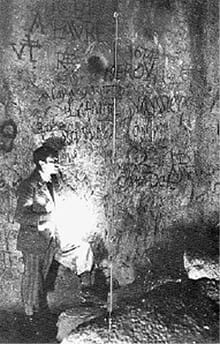 Sadly it didn't work out that way for ol' Otto. He was murdered by the Nazis in 1939 and the secret of the Cathars was thought to have died with him. Some believe the SS sealed the cup into a mineshaft at the base of a glacier near the abandoned Obersalzburg complex, or that it was shipped to a secret U-boat base in Antarctica at the end of the war, while others say it never left France at all and remained in the hands of wily old Gadal, the director of tourism.
Sadly it didn't work out that way for ol' Otto. He was murdered by the Nazis in 1939 and the secret of the Cathars was thought to have died with him. Some believe the SS sealed the cup into a mineshaft at the base of a glacier near the abandoned Obersalzburg complex, or that it was shipped to a secret U-boat base in Antarctica at the end of the war, while others say it never left France at all and remained in the hands of wily old Gadal, the director of tourism.
Gadal lived on in Ussat 'til his death in the 60's, and after the war, became the head of the European Rosicrucian movement, reforming it along his own strange 'neo-cathar' lines. My previous research suggests the meteoric vessel remains in their hands and is probably used in their initiation rituals, which continue to take place in the Bethlehem Grotto in Ussat. There is evidence the chalice was publicly exhibited at one point in the museum in Tarascon, the home of former president Mitterand, and now a bastion of neo-nationalists and the French hard right. The former curator of the museum had initially refused to be interviewed for fear he could be implicated in the 'Solar Temple' murders.
The now-disbanded 'Solar Temple' was an obscure right wing sect that counted Princess Grace of Monaco among its members. The sect all but disbanded over a decade ago after a series of still unexplained mass murders in Quebec, France and the tiny town of Sion in Switzerland, the bodies of Temple members (all of them respectable local bankers, politicians and town functionaries) were found (after synchronised fire bomb explosions in Canada and France!) arranged twelve to a group like the spokes of a wheel, heads pointing inwards, hands tied behind them, gunshot wounds in the backs of their heads. All told some 74 people died in Switzerland alone and at least a further 16 in Quebec.
About all you can be sure of is it wasn't suicide! Otto's journal mentions a similar arrangement of Cathar remains from a 12th century grave. There were twelve knights at the round table, the thirteenth chair being vacant, the Siege Perilous. Twelve disciples at the last supper, twelve houses of the zodiac, twelve little pips around the borders of the Cathar cross, twelve departments in the SS, twelve seats at Himmler's round table, twelve empty plinths in the circular Valhalla room or Hall of the Dead beneath the Wewelsberg, twelve men to a workgroup at the local Niederghagen concentration camp (worked systematically to death under the principal of extermination through labour) and twelve standing stones surrounding Gadal's grave on the banks of the Ariege.
Despite my best efforts to co-erce or cojole the secret of the 'Pyrenean Grail's current whereabouts from the former curator, I failed to ever get within striking distance of the relic itself, although I believe it is still somewhere in the valley of Ussat and probably in the hands of a secret society, who use it in their initiation rituals. After seven years, I knew we were still only beginning to understand what the story was really about. I knew the stones had been prized since time out of mind, and that men might kill or die for them, yet without having yet conducted a full spectrograph, had few clues as to their density or the true nature of the other mysterious properties attributed to them. Chemical density is determined within the first few seconds of the 'big bang'. On Earth, the heaviest element in the existing periodic table is Uranium, which can be artificially enriched to form Plutonium and of course, there's really only one thing that Plutonium is good for!
In deep space, far heavier stable elements are known to exist, some of them dense enough to bend light or literally fold space-time, each one containing the latent energy of the original light, the 'big bang', still trapped within it and awaiting some future redemption, like the souls of the 'Cathars' imprisoned in their 'tunics of flesh.' The 'Cathars' accepted Christ only as a prophet and awaited the coming of a true messiah, who would incarnate not as a human being but as pure light, a light that would liberate us all from the 'sin of matter', cleanse the Earth, break the cycle of incarnation and bring us back to God.
The 'Graal Pyrenean' is identified by some as the Emerald Cup, not because of its shade but because of what it holds within it, indetectable to mortal eyes, what the deranged Nazi Ariosophist Miguel Serrano described as 'the green ray' or the 'condensed light of the black sun.' There is some evidence to suggest that several artifacts from Rahn's initial excavations were shipped to the United States just before the war, where they later came to the attention of one of Albert Einstein's associates, a young physicist named Dr. Herbert Fleishmann, who had a particular interest in the fields of superconductivity and supercooling. The military applications of his work remain classified, along with the details of the first and second SS Polar expeditions, in which Rahn seems to have played a role. Murky 16mm footage exists, depicting some sort of radar apparatus reminiscent of the transmitters found today at the United States installation at Gaakon, Alaska, and some believe that research continues in secret at the American airbase in Thule, Greenland, a former Nazi installation that came over to Allied administration after the war under 'Operation Paperclip'.
But it's all speculation and without tangible evidence will remain so. Like Fulcanelli's incomplete trilogy, the 'overture to the invisible', the notorious 'verbum dismissum' of the alchemists, Rahn's work remains incomplete. He speaks of three stones after all...
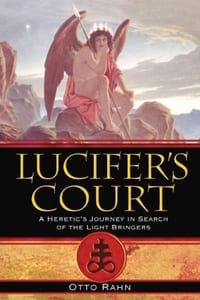 In the final pages of The Court of Lucifer, written in 1936, a good three years before his lonely demise, Otto describes three completed manuscripts resting before him on his writing desk. On the first pile, the notes that comprised the substance of Crusade against the Grail rest one of the black stones he brought back from Montsegur, on the second, the text of The Court of Lucifer rests a fragment of the Delphi oracle frieze, and on the third, what he promised would be his final and greatest work rests a 'lump of amber, golden yellow', reminiscent of Masonry's three degrees and the whitened final substance of the alchemical 'great work'. The third book of Rahn, begun at the Arctic Circle under the working title Orpheus or A Journey to Hell and Beyond is of course missing, either seized by the Nazis when he fled the SS, or (as his niece Ingeborg would have us believe) burned by his mother at the end of the war.
In the final pages of The Court of Lucifer, written in 1936, a good three years before his lonely demise, Otto describes three completed manuscripts resting before him on his writing desk. On the first pile, the notes that comprised the substance of Crusade against the Grail rest one of the black stones he brought back from Montsegur, on the second, the text of The Court of Lucifer rests a fragment of the Delphi oracle frieze, and on the third, what he promised would be his final and greatest work rests a 'lump of amber, golden yellow', reminiscent of Masonry's three degrees and the whitened final substance of the alchemical 'great work'. The third book of Rahn, begun at the Arctic Circle under the working title Orpheus or A Journey to Hell and Beyond is of course missing, either seized by the Nazis when he fled the SS, or (as his niece Ingeborg would have us believe) burned by his mother at the end of the war.
Rahn's sensational earlier work lead to him being feted by the Nazi elite and for a few years, his research had been lavishly funded by the Race and Settlement department. Then something went disasterously wrong. In 1939, he was accused of being both a Jew and a homosexual and placed before a military tribunal. The department responsible for commissioning him was disbanded and Rahn went on the run. The last people to see him alive were two children playing in the snow outside a farmhouse on the slopes of the Kufstein in southern Germany.
According to the oldest of the children, Peter Meier, a tall man dressed in black appeared from the treeline and paused to ask the time. It was late in the day and fearing for the stranger, their parents later went to look for him, but even though the snow was more than a metre deep, found to their surprise he had left no footprints. The following spring a body was discovered only a few hundred feet from the back of the house. Otto had apparently walked up the stream to avoid leaving tracks, before sitting down under on of the trees to swallow a cocktail of pills. According to the report filed by the police in Zoll, however, the pills didn't kill him. He froze to death.
An obituary appeared on May 18th in the Berliner Ausgabe, filed by Rahn's former associate, Karl Wolff<:
In a sudden storm in the mountains in March or January, SS Obersturmfuhrer Otto Rahn tragically lost his life. We mourn the loss of our comrade, a good and decent SS man and writer of noted historical, scholarly works - signed SS Chief of Staff, Obergruppenfuhrer Wolff.
Of course, we only have Wolff's word it happened that way and taking the SS's word at face value was never a good idea to begin with. There's plenty wrong with the official account, not the least of it the fact that although Otto seems to have been on the run, no-one seems to have bothered looking for him. The body lay in the snow for months, yet his family confirm that no-one ever asked after him or called to investigate his abrupt disappearance, which is a little unusual in a police state such as Germany had then become. Of course, the good folk at the SS Order castle acted as if they had known where Rahn was all along, which they probably did...
Himmler's adjutant, Rahn's obituarist, Karl Wolff later became the Nazi ambassador to the Vatican and survived the war. He was granted immunity for his crimes by agreeing to testify against his former comrades at Nuremberg and later became well-known as one of the principal interviewees and narrators of the BBC series The World at War<, as well as playing an active role in discrediting the 'Hitler diaries' for Stern Magazine and helping bring Klaus Barbie to justice in Paraguay. I was mercifully born too late to have attended Nuremberg, but I did get to sit in on the famous libel trial at River City's high court a few years ago, that resulted in the subsequent downfall of British pseudo-historian and holocaust denier David Irving.
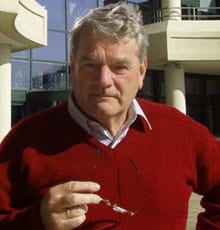 Irving had consistently attacked the credibility of the experts introduced to counter his claims that a deliberate policy of mass extermination had never been practiced at Auschwitz or, by implication, the other camps, so when the prosecuting attorney introduced Karl Wolff's testimony, he couldn't help quipping:
Irving had consistently attacked the credibility of the experts introduced to counter his claims that a deliberate policy of mass extermination had never been practiced at Auschwitz or, by implication, the other camps, so when the prosecuting attorney introduced Karl Wolff's testimony, he couldn't help quipping:
"Someone like you would probably consider the Reichsfuhrer's personal adjutant to be a credible witness, would you not?"
Ignoring the polite murmur of laughter from the audience, Irving screwed up his eyes and remarked:
"Well, it's a bit of a curate's egg, really..."
And the funny thing is I know what he means.
Only it ain't funny!
In the course of my own research I collated, translated and compiled literally hundreds of pages of testimony, documents and journal entries, that charted Rahn's quest for the roots of an authentic European 'Ur- religion', a body of invaluable folkloric data from a pre-war Europe now lost to us. His work has informed my own and opened my eyes to much of what I had inadvertently stumbled across. While the body of this material has now been transferred to disc and could be downloaded at the touch of a key, Margaret Thatcher and Marie Denarnaud< may have had a point. There are some things you just 'can't tell the public'.
Regardless of its merit, Rahn's magnum opus was required reading at a certain level of promotion within the SS and, inadvertently or otherwise, contributed to the ideological underpinnings of the holocaust. The figure of six million Hebrew martyrs so hotly disputed by Irving and his dodgy ilke sadly obscures the wider picture. Let's get this straight, o my brothers, seventy two million people lost their lives in WW2 in mainland Europe alone, and with those sort of figures you don't crap around with fate.
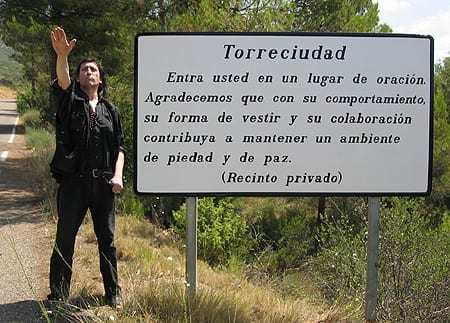
Opus Dei Headquarters - Torreciudad, Spain - Summer 2007
Like Heinrich Himmler, who took time off from hobnobbing with Franco to make obeissance to 'La Morenita', the founder of Opus Dei, the recently canonized Cardinal Escriva drew inspiration from the magic mountain and Savanarolla's Knights of Heaven. In practise, they amount to a sort of Catholic equivalent of the Taliban, and to make matters worse they're rich, relentless and in government right here in Europe. It's like the Spanish Civil War never even happened...
Sometimes the underground stream ducks out of sight. Sometimes the trail seems to go cold and so-called 'real' life takes pririority. Its just the way of things. There be no other...
The only way you could ever prove whether or not it was really Otto's body in that grave in Darmstadt would be to exhume his remains and effectively conduct an independent autopsy, something well beyond my limited means. The only way to learn the truth about what happened to him at the Pole, Dr. Fleischmann and the continuing experiments at Thule, would be to somehow track down the missing manuscript or access the redacted files which seems equally improbable.
We kept going until we ran out of funds and film stock, and when we were done with The Secret Glory, we split the artifacts we had recovered from the caves and Rahn's effects equally between myself, Mr. Horn, and the other Shadow Theatre irregulars, who had given freely of their time and energy along the way. We divided the stones as fairly as possible before reluctantly winding down the operation and going our separate ways. The four horsemen were abroad in the land and there were wars and rumors of war.
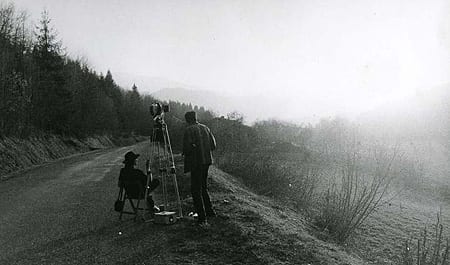
Secret Glory - Crew Photo - Self and Mr.Horn on the road to the Grail Castle - Autumn 1998
I hadn't broken bread with Dario in some years, and for a while I think I actively avoided him. I acted partly out of guilt over having left him in the lurch at Raleigh Studios and having unfinished business with his daughter. However, I suspect the real reason I kept my head down was that I simply didn't know what to say. I mean what is there to say about The Phantom of the Opera<, other than 'no comment'?
Asia kept in touch for a while and I received postcards from distant cities on all four sides of the earth bearing cryptic, scrawled messages from cities . As my career idled, hers hit the fasttrack with roles in La Reine Margot< and XXX<, thrusting her into the fickle limelight she claimed to abhor. In the hothouse glare her talent blossomed, just as the fortunes of all who loved and worked with her invariably seemed to flicker and wane, as if the creative energy had been juiced right out of them. While they seemed made for each other in theory, her attempts to collaborate with her father seemed to consistently misfire.
While I had tried to defend Trauma<, and love Stendahl's Syndrome< despite its flaws, Phantom was in a class of its own, and for once I had no desire to watch the film a second time. Sitting through it was like being forced to watch my parents making love, or more to the point, contemplating their naked, tangled corpses. The experience left me defeated, demoralized and diminuished as if a part of my childhood had not so much died as been tarred and feathered, set on fire and then drowned in its own vomit. The continuing theme of rebellion against the dominating patriarchy, now explicitly identified with the paedophillic director of the opera house, and the bland phantom's efforts to groom the young ingenue to stardom, only made it clearer than ever that Asia would have to escape her fathers loving clutches, if she were ever to fulfill her own potential, but to be fair on il maestro, he wasn't the only director to be overwhelmed and ultimately defeated by Asia's presence, hampering her budding career with a string of high profile disasters.
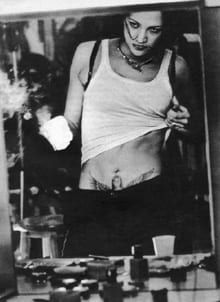 Michael Radford, recently feted by the Academy for Il Postino<, fell head over heels for her hungry eyes and crafted the execrable B. Monkey< accordingly. They say that love is blind but that's scarcely an excuse. Abel Ferrara fell just as hard and his erratic career took an abrupt nose-dive halfway through New Rose Hotel<, from whence it never fully recovered. And as for George Romero and Land of the Dead<? What can I say? But it hurt. It hurt bad. You know it did...
Michael Radford, recently feted by the Academy for Il Postino<, fell head over heels for her hungry eyes and crafted the execrable B. Monkey< accordingly. They say that love is blind but that's scarcely an excuse. Abel Ferrara fell just as hard and his erratic career took an abrupt nose-dive halfway through New Rose Hotel<, from whence it never fully recovered. And as for George Romero and Land of the Dead<? What can I say? But it hurt. It hurt bad. You know it did...
Asia had worked with some of the best directors in the business, legendary figures one and all, and by now it must have been obvious even to her that she could do a better job with both hands tied behind her back. Betrayed by a string of would-be mentors and surrogate father figures, she did the only thing she could, and assuming responsibility for her own career took hold of the reigns to direct herself in Scarlet Diva<, a ghastly autobiographical glimpse behind the mirror, that comes across more like a cry for help than an actual 'for real' attempt at a motion picture. Nonetheless, it still packed a hell of a lot more anger and toxic energy than anything her old man had done in years.
Asia seemed to have not only inherited il maestro's pathological tendency to air his psychological linen in public, but had gone one step further by casting her mother, Daria Nicoldi, as her abusive, alcoholic mother and recruiting her friends to largely play themselves, happily tearing down the remaining barriers between the movies and so-called 'real life', the two blurring irrevocably into a single skuzzy, softcore gestalt.
Interesting, I thought. Not exactly a movie I wanted to take home with me, but definitely interesting.
Unsurprisingly, the public failed to identify with Scarlet Diva's central theme, just how damn hard it is to be Asia Argento, and the film subsequently vanished without a trace, performing just well enough on DVD to bankroll her second, more tightly focused opus.
While The Heart is Deceitful Above All Things< marks a quantum improvement over Miss Argento's earlier work as a director, I couldn't help but wonder if Asia wasn't the only person on the planet not to have realized that author J. T. Leroy was really just a woman wearing a funny hat rather than a bi-sexual rent boy or bonafide hermaphrodite. Although this second purgative offering failed to register any more strongly on the box office radar than its predecessor, it was clear the maestro's heir apparent was learning fast and it seemed only a matter of time before she'd gather the courage to steal her father's rainmaking magic while he slept and finally come into her own.
I didn't run into Dario again until the premier of his subsequent feature at Gerardmer in the icy winter of 2001.

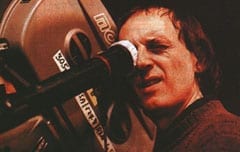
While hardly vintage stuff, Sleepless< (2001) seemed a step in the right direction, a retreat from Phantom's abyss to the familiar territory of the 'giallo', the genre the master had made his own, yet the familiarity of the material only served as a reminder of the trailblazing frissons of his youth, offering a scratch mix of Deep Red<, Opera< and the Animal Trilogy that began it all, en lieu of any real personality of its own as if we were watching a slickly rendered homage to his own work, ersatz Argento rather than the real deal, like Geoff Love or Hugo Montenegro covering a Morricone original. And if il maestro was running on auto-pilot then so was his star.
The presence of Max von Sydow in the rehashed Karl Malden role (from Cat O' Nine Tails<) raised my initial expectations, but the great man was too far down the pike from The Seventh Seal< to be able to make any real difference to the formulaic material, sleepwalking through his turn as an Italian (!?!) cop every bit as unlikely as Asia's doomed Inspector Manni in Stendahl Syndrome, whilst grappling with some of the clunkiest English language dialogue in il maestro's ouvre, and running the very real risk of being upstaged by smartass talking parrot with whom the visibly uncomfortable lead finds himself closeted for much of the flick's running time, the latest and surely most ludicrous addition to the long line of Argento's crimebusting birds, friendly flies, cursed cats and other unlikely animal protagonists.
The neo-Goblin score was a distinct improvement over Morricone's recent contributions to the canon, but il maestro's inexplicable obsession with dwarfs and the desperate slapstick that added the final height-related insult to Phantom's aesthetic injury, spilled over to infect even the normally dependable Claudio Simonetti, who hit an all time low with an insufferable 'funny midget' theme, that seemed to have strayed in from Living in Oblivion<'s darkest nightmares. Asia's absence came as a breath of fresh air, although she somehow managed to cast a deadening hand on the project even at a distance by penning the stilted nursery rhyme that the leads are forced to repeat over and over, as if in the hope it might somehow improve in the telling. According to Alan Jones, this worked a lot better in Italian but I remain to be convinced.
It had been seven years since that night at Raleigh Studios and at first I thought he wouldn't even recognize me. I had been at the height of my fifteen minutes of pseudo-fame the last time we had met, with an office off Sunset, a p.a to run my social calendar, limo service, the whole bit. Now I was an itinerant former dogman at odds with the intelligence community and up to my eyeballs in a smoky fug of post-9/11 paranoia, but il maestro's gaunt, beleagured face lit up as our gaze met. The insouciance he'd shown at the National Film Theatre was gone, stripped away by the savaging Phantom had received, and while, to some extent, Sleepless marked a return to form, he was as keenly aware of its shortcomings as his sternest critic, and grateful for a friendly face in a crowd, he feared, had come to bury him regardless. A director is a general in charge of an army of traitors like any showman. An audience will love you, laugh with you and wait outside your stage door when you're hot and on a roll, but no audience is ever truly friendly. Not for long. Bore 'em or disappoint 'em - even once - and they'll turn on you and tear you to pieces, regardless of who you are or might once have been.
It was all the master could do; to say a few short words by way of an introduction before making a bee-line for the exit, not wanting to stick around to see what happened, and with no intention of staying for the traditional Q and A. Those days of easy interaction with the fans were gone for good, it seemed, or until the stars came round again to their right place and time. It was the winter of 2001. Donnie Darko< was plainly the film of the festival. My mentor was no longer the daemon he once was, no longer the undisputed master of the macabre, but whatever I was, I wasn't even a filmmaker anymore, but that didn't matter to him now, any more than it had when we first met. All that really counted was that we were both still alive, still smoking and still friends despite it all.
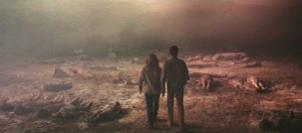
Circling around the back of the cinema complex to avoid the festival organizers, we struck out across the surface of the frozen lake, giggling like school children as the world faded behind us, the far shore lost in the icy mist as if we had passed alive into Fulci's The Beyond<. I had brought a li'l smoke for old times sake and for a while, it really was just like old times, all the better perhaps because neither of us honestly gave a damn about what anyone thought anymore.
When the cold began to seep into us, we ducked into another preview theatre at random and found ourselves by chance in the front row of a sparsely attended screening of what turned out to be Ernest Dickerson's Bones< (2001).
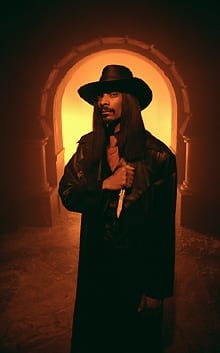 We'd missed the first ten minutes but rapidly surmised that we were not only watching an uncredited remake of the 1979 blaxploitation thriller J.D.'s Revenge<, and a homage, intentionally or otherwise, to our own material with the nods extending to Snoop Dogg returning from hell complete with black hat, coat and glowing eyes.
We'd missed the first ten minutes but rapidly surmised that we were not only watching an uncredited remake of the 1979 blaxploitation thriller J.D.'s Revenge<, and a homage, intentionally or otherwise, to our own material with the nods extending to Snoop Dogg returning from hell complete with black hat, coat and glowing eyes.
The spectacle of Snoop trying to make like a certain demi-goth from Stevenage seemed somehow even more absurd than Ali G. trying to make like Snoop, and before long we were both in hysterics. "What have you done to these kids?" muttered Dario. "It's not my fault. You started it!"
But it wasn't our fault at all. At least not directly. As the end roller duly made clear. Our mutual friend Adam Simon, who had given Dario his translation of the Sefir Yetzirah, the Book of Creation, had been responsible for the screenplay, if not specifically for Snoop's costume, and the sight of his name brought us full circle to that night in Malibu, one more tiny link in the invisible lattice of coincidence, an ironic reminder of the forces that had really been in charge all along, that directed our actions through dreams, through pulses in secret rivers, through signs in heaven and changes on earth, heraldries painted on darkness and hieroglyphs graven on the tablets of our brains. They wheeled in mazes. We merely spelled the steps and tried to read the signals. They conspired together and on the mirrors of darkness our eyes had traced the plots our waking minds could scarcely contain. Theirs were the symbols. Ours the images, that struggled to convey them...
Then the munchies kicked in and retreating to the far corner of a late night bistro, I watched Dario put away two courses, while I got him up to speed with what had happened in the Pyrenees, slipping the bleeding stones from my pocket as proof I hadn't been hallucinating all along. Then, casting one eye over the dessert menu, il maestro began for the first time to discuss the Third Mother. He had just gotten back from a sojourn in Haiti and like myself, was increasingly convinced that the ecstatic faith of the magic island was a living example of what had once been a pan-European phenomena, an ur-religion rooted in the Goddess worship of ancient Rome and the so-called 'Tarantula Cults' of the dark ages, a white Voodoo that survives hidden by successive masks down through the ages.
She had been waiting for her time to come round for some many years, haunting our dreams but from the very first time I heard the icy tinkle of those tiny silver keys and glimpsed her pale bowed face in my mind's eye, there had been something hauntingly familiar about her high forehead and long, dark hair. There was even then only one clear choice, only one vessel, one conduit, one player who could truly embody the role.
We both knew how much was at stake, Dario most of all, and he had put off the inevitable for as long as possible but we were running out of time and he had to finish it, to complete the circle while there was still a chance. He knew what was at stake and tried to distract himself developing a script entitled Dark Glasses and then abandoning it, along with a rough sketch for a Venetian giallo, marking time with The Card Player< while the last few pieces of the puzzle fell into place.
And in the meantime the lunatic soap opera we take to be 'real life' roared on.
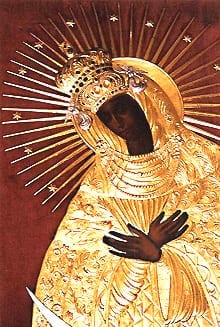 The second Gulf War broke out just as I was sitting down to breakfast with Alejandro Jodorowsky in a dingy hotel dining room in Brussels. When I pointed out that this had happened before the last time we met, Jodo' blanked on me, unable to recall the events in question. He was quite adamant we had never met before, nor had he ever seen or heard of my work or served on any festival jury such as the one I described. In any case, he insisted he was a poet, not a filmmaker, and claimed to have no further interest in motion pictures which he considered a passing fad rather than a medium suitable for bona fide adult artists. I nodded along, keeping one eye on the television screen in the corner of the room, content that at least this time the great man didn't seem to have any problem with my smoking, which passed unnoticed.
The second Gulf War broke out just as I was sitting down to breakfast with Alejandro Jodorowsky in a dingy hotel dining room in Brussels. When I pointed out that this had happened before the last time we met, Jodo' blanked on me, unable to recall the events in question. He was quite adamant we had never met before, nor had he ever seen or heard of my work or served on any festival jury such as the one I described. In any case, he insisted he was a poet, not a filmmaker, and claimed to have no further interest in motion pictures which he considered a passing fad rather than a medium suitable for bona fide adult artists. I nodded along, keeping one eye on the television screen in the corner of the room, content that at least this time the great man didn't seem to have any problem with my smoking, which passed unnoticed.
Jodo' had come to Brussels to perform his much touted 'magical cabaret' for the last time, and anxious adherents had come from all across Europe to get the benefit. Sadly, events in got in the way just as they had precluded any chance of esoteric discourse when we had first met back in 1990. Canceling his show at the eleventh hour, Jodo' announced to a packed house that magic had no place in wartime and that instead he would read them an epic composition he had recently penned as an 'act of revolutionary poetry'. The screed was in French so I didn't stick around, and later I heard Jodo' cut his impromptu reading short and bottled it when the crowd turned ugly. Perhaps I should have reminded him that a magician and a poet is still a showman and a general like any other, but I doubt he would have heard me. Not that I had an audience myself, mind you, but then I didn't need one. For now the magic was reward enough!
My mother had expressed a growing desire to see all the places I had told her about during her convalescence, and when she was strong enough, took her to meet the Black Madonna. Again I rode the cablecar through the curling eternal mists and joined the queue of pilgrims winding in single file through the basilica to touch the globe in La Morenita's extended hand, and if I wished for anything, this time it was merely for the right thing to happen, for my eyes to penetrate the toxic 21st century haze and my ears to hear her whisper once more, for my heart to know her mysteries ever more keenly, so that I might at last find the words and images to express the inexpressible.
And that night I climbed the mountain and gazed by starlight once more upon the faces of those antehuman Gods. And I waited for a sign perhaps. And waited again. But the Gods were silent.
We made an early start and headed north across the Pyranees by way of Andorra and the valley of Ussat to Montsegur and Madame Couquet's auberge, where the first fire of the season already smouldered on the hearth. Madame greeted us with open arms, looking somehow younger than when I saw her last. The old inn was the closest I had come to a real home over the years, and despite the language barrier, she struck up an instant rapport with my mother that was to become a lasting, almost intuitive bond. Strange and oddly reassuring as it was to see these two matriarchs together at the long table, the homecoming was not complete without a third mother, a third replica of the Madonna of Montserrat that I had purchased the day before in Spain and presented now to Madame Couquet to watch over the auberge.
"Merci. It's very nice. But we already have one."
"What?"
"She says she's already got one."
"Thanks mom. I can... What d'you mean she's already got one?"
"Ouie, ouie!" Madame nodded, trying to explain in her heavily accented Southern French. "Notre Dame la Lumiere!"
"You mean a replica like the one I got in New York?"
"No. A real one."
And it was true...
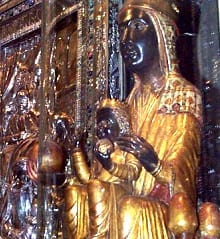 The third mother had been there all along, hidden in plain sight in the tiny church opposite the auberge. To be fair, the chapel was locked six out of seven days and Sunday mornings in Montsegur had invariably found me either still in bed or camped out on the mountain. The last thing any of us had thought to do over the years in course of getting with the whole Cathar deal was to go to mass.
The third mother had been there all along, hidden in plain sight in the tiny church opposite the auberge. To be fair, the chapel was locked six out of seven days and Sunday mornings in Montsegur had invariably found me either still in bed or camped out on the mountain. The last thing any of us had thought to do over the years in course of getting with the whole Cathar deal was to go to mass.
And there she was. Beautiful, cryptic, proud, staring out from the dust of three hundred years since monks from Montserrat had first brought Her from the far side of the mountains to symbolize their spiritual kinship with the hardy villagers of Montsegur, explicitly drawing together and linking the initiatory mountains in a way that Otto had scarcely guessed at. He had spent enough time at Montserrat to familiarize himself with the Benedictine library reading room and drew on its medieval texts in his research, but in his haste to denigrate the Catholic faith responsible for the extermination of his beloved Cathari, he blinded himself to the common pagan roots that bound these ancient sites together, roots that were deeper and older than Christianity and its heretical antithesis.
"My ancestors were witches and I am a heretic", wrote Otto and in his natural revulsion for the inquisition and championing of the lost ideals of the troubadours, he missed what had been right under his nose all along. He derided the faith of Madame Couquet's father, the town priest who had given him lodging, and never set foot inside the church to catch sight of that all-important icon, the Black Mother who had been venerated in those mountains by one name or another since time out of mind.
If he did see the image in the church he made no mention of it, nor did he remark on the crude yet unmistakable outline of the arachnid daubed on the wall of the cavern, where he first unearthed those bleeding stones that would help speed him towards his early grave. You can see that telltale graffiti for yourselves, large as life in the montage that opens the Subversive DVD release of The Secret Glory, where it simply flits by without comment or context. Yet it is there.
Perhaps in his haste to identify Montsegur with the mythical 'Grail Castle', he overlooked the fundamental contradiction of a heretical faith that viewed the material world as being inherently flawed, having a material treasure to begin with. It was not in the nature of the Cathari to venerate relics in the manner of the Catholic church, and the sight of the blood of Christ liquifying from the living rock tends to lose much of its superstitious charge if the attendant culture doesn't accept the existence or theological relevance of a flesh and blood messiah to begin with.
 As with the consistent conflation of the ancient Celts, the Druids, Beaker folk and megalith builders of Stonehenge and Avebury into a single mythic culture by the modern New age movement, it was all too easy before the advent of reliable carbon-dating and other techniques common to modern archeology to misidentify the shrapnel of a dozen time periods as the residue of a single 'old religion', and it transpires that the caves of the Lombrives have been continuously inhabited since the end of the last ice age. It is my considered contention that Otto Wilhelm Rahn and Antonin Gadal did not find the 'holy grail' or the mythical 'treasure of the Cathars' but the relics of a far older cult that had held those caverns sacred long years before Christ and his cup, the Cathari or Abraham and the prophets.
As with the consistent conflation of the ancient Celts, the Druids, Beaker folk and megalith builders of Stonehenge and Avebury into a single mythic culture by the modern New age movement, it was all too easy before the advent of reliable carbon-dating and other techniques common to modern archeology to misidentify the shrapnel of a dozen time periods as the residue of a single 'old religion', and it transpires that the caves of the Lombrives have been continuously inhabited since the end of the last ice age. It is my considered contention that Otto Wilhelm Rahn and Antonin Gadal did not find the 'holy grail' or the mythical 'treasure of the Cathars' but the relics of a far older cult that had held those caverns sacred long years before Christ and his cup, the Cathari or Abraham and the prophets.
Before the Blessed Virgin Mary or the Black Madonna, before Kybele, or Cybele, or Sybil, she was known as Kubaba, the goddess of the caves, who was worshipped in grottos and on mountaintops since the dim-red dawn of creation and known to her adherents as the Great Mother - Magna Mater or Meter Orie, the 'mountain mother', and by whose name we know the black stones that have been associated with her worship since the fogs of timeless time. Meteorites; quite literally the 'stones of the Mountain Mother'.
The stones that fell from heaven were venerated, not because of their extraterrestrial origins which primitive man could barely have guessed at, but because their alleged physical properties - the power to heal grave illness, protect against one's enemies and grant the gift of prophecy - are so closely intertwined with the veneration of the Black Mother that the two are effectively one and the same. The ideograms for the 'mountain mother' in the Hittite alphabet range from a lozenge or cube, a double-headed axe, a dove, a cup, a door or a gate - all images of the goddess in Neolithic Europe. The very name Kubaba may betoken a cave or empty vessel, a wombspace or possibly derive from kube or kuba, recalling at once the black meteoric cube of the Ka'bah, that was brought into Islam after Mohammed routed its original idolatrous worshippers out of Mecca.
 It is said that in pagan times, the seven priestesses of the Ka'bah circled the black stone naked as when the world was yet young. Today that practice is still recalled in the tawaf, the sevenfold counterclockwise circuit of the shrine, performed by all pilgrims to take the Hadj. The ancient rituals roots almost certainly descend from the Sumerian goddess Inanna and her Babylonian equivalent Ishtar, who was supposed to have passed through the seven doors of death or 'seven gateways' on her journey to the underworld, each successive gate keeper demanding she remove a garment as tribute, until she finally stood naked before her elder sister Ereshkigal, 'Queen of the Great Earth', goddess of the underworld, a dance of death clearly echoed in the later Christian myth of Salome and the 'seven veils'.
It is said that in pagan times, the seven priestesses of the Ka'bah circled the black stone naked as when the world was yet young. Today that practice is still recalled in the tawaf, the sevenfold counterclockwise circuit of the shrine, performed by all pilgrims to take the Hadj. The ancient rituals roots almost certainly descend from the Sumerian goddess Inanna and her Babylonian equivalent Ishtar, who was supposed to have passed through the seven doors of death or 'seven gateways' on her journey to the underworld, each successive gate keeper demanding she remove a garment as tribute, until she finally stood naked before her elder sister Ereshkigal, 'Queen of the Great Earth', goddess of the underworld, a dance of death clearly echoed in the later Christian myth of Salome and the 'seven veils'.
Erishkigal is also known by the epithet 'Allatu' (literally 'the goddess'), which is beyond question an earlier form of Al'Lat or Alilat, identified by Herodotus in the fifth century B.C. as the divinity worshipped in Mecca before the coming of the prophet, Mohammed and the substitution and subsequent veneration of her partriarchal counterpart, Allah - essentially the goddess Al'Lat with a soft 't'.
Al'lat has been identified with the three-fold moon goddess codeified by Robert Graves into the archetypes of virgin, hag and whore, whereas in the introduction to the Penguin edition of the Koran translator N.J. Dawood states that the three mothers Al'Lat, Al'Uzza and Manat represent 'the Sun, Venus and Fortune, respectively' and the writer Alby Stone suggests that in early Mesopotamian art the only heavenly bodies to be depicted regularly were a trinity of the Sun, the Moon and Venus, tracing the roots of the names 'Al'uzza' and 'Manat' to an even more archaic source, betokening 'strength' and 'destiny', respectively.
If the three 'daughters of Allah' are personifications of natural phenomena, then Al'Lat/ Allatu/ Ereshkigal is surely the earth, while the other two may well have stood for fire and water as in the Book of Creation, the Sefir Yetzirah or for that matter the 'banat', the three daughters of Baal, the Canaanite supreme being. Islamic oral tradition (al-Hadith: 'The Talk') has it that Mohammed's original vision initially endorsed the notion that the three mothers were goddesses, but he apparently later disowned this as a false teaching inspired by Satan. (Mircea Eliade: A History of Religious Ideas, vol.3, p.68)
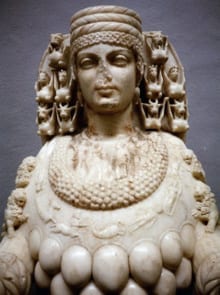 At Petra, the nabateans venerated a four-sided stone named after Allat (Arthur Cotterell, Dictionary of World Mythology, p. 24), whose son Dusura is just another take on Tammuz/ Dumuzi/ Du'uzi, the green man, who dies only to be reborn every spring after six months in the underworld. The Sumerians called him 'Dumu-zi'abzu' ('faithful son of the abyssal waters'), and believed that as in the later myth of Orpheus and Persephone, the goddess Ishtar/ Inanna was forced to descend to the underworld to retrieve him. Her actions provoked the wrath of the Gods and she was sentenced by the seven Anunnaki, the judges of the underworld, the hellacious counterparts of the Sebettu, the seven sages venerated by the Babylonians, and associated with the seven major cities that dominated their civilization.
At Petra, the nabateans venerated a four-sided stone named after Allat (Arthur Cotterell, Dictionary of World Mythology, p. 24), whose son Dusura is just another take on Tammuz/ Dumuzi/ Du'uzi, the green man, who dies only to be reborn every spring after six months in the underworld. The Sumerians called him 'Dumu-zi'abzu' ('faithful son of the abyssal waters'), and believed that as in the later myth of Orpheus and Persephone, the goddess Ishtar/ Inanna was forced to descend to the underworld to retrieve him. Her actions provoked the wrath of the Gods and she was sentenced by the seven Anunnaki, the judges of the underworld, the hellacious counterparts of the Sebettu, the seven sages venerated by the Babylonians, and associated with the seven major cities that dominated their civilization.
The three most sacred sites in Islam are Mecca, Medina and the Dome of the Rock on Temple mount, Jerusalem, which is identified in Judaism as the 'Eben Shettiyah', the 'stone of foundation', around which God built the world. Deep beneath the rock is a partly flooded cavity known to Muslims as 'Bir-el-Arweh', or the 'Well of Souls', and Jewish lore maintains how when David dug the foundations of the first temple he found the 'Eben Shettiyah', the block that holds back the Abyss. When he tried to move the stone, the waters of the underworld burst forth mirroring a parallel tradition in Islam, which holds that when Mohammed cast down the idol that once stood in the sacred complex at Mecca, he unblocked an ancient well beneath the Ka'bah. The idol was said to resemble the body of a 'black woman', a deity named 'Hubal', almost certainly another mask of Kubaba or Cybele, who was known to be venerated at that time in Phrygia.
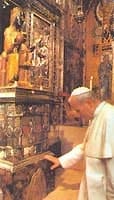 In fact, a Phrygian statue of Cybele graven from a single meteoric 'aerolite' (Cumont, Oriental Religions in Roman Paganism, 1911, pp.46-7) was apparently presented to Rome by King Attalus in 204 BC. The ecstatic rites of Cybele's worship, whilst initially a little alien to the Roman temperament, seem to have caught on with the populace, who venerated her in the Phyrgianum, the vast temple that once stood on the site of the present-day Vatican. The high priest who presided over those frenzied rituals was known as 'Papus', or father, the direct ancestor of the present day Pope, the head of the patriarchal Holy Roman Church. As her worship spread throughout the Empire, icons made in her image proliferated, painted black not because of the skin of the Egyptians, the dark alluvial soil of the Nile, or some obscure Arabic root word, but because the template on which she is based, the original statue that held sway over Rome was made of a black stone. Behind the masks of Christianity and Islam the Goddess, the Grail and the bleeding stones were one all along.
In fact, a Phrygian statue of Cybele graven from a single meteoric 'aerolite' (Cumont, Oriental Religions in Roman Paganism, 1911, pp.46-7) was apparently presented to Rome by King Attalus in 204 BC. The ecstatic rites of Cybele's worship, whilst initially a little alien to the Roman temperament, seem to have caught on with the populace, who venerated her in the Phyrgianum, the vast temple that once stood on the site of the present-day Vatican. The high priest who presided over those frenzied rituals was known as 'Papus', or father, the direct ancestor of the present day Pope, the head of the patriarchal Holy Roman Church. As her worship spread throughout the Empire, icons made in her image proliferated, painted black not because of the skin of the Egyptians, the dark alluvial soil of the Nile, or some obscure Arabic root word, but because the template on which she is based, the original statue that held sway over Rome was made of a black stone. Behind the masks of Christianity and Islam the Goddess, the Grail and the bleeding stones were one all along.
The original idol may still exist somewhere deep beneath the walls of the Vatican, although it is said to have been lost in the fifth century. To some extent, the Vatican's interest in Montserrat is indicative of the continuing power of the goddess cult within the edifice of the Church itself, and the extraordinary degree of theological doublethink deployed to maintain the existing partriarchal order and keep the wool pulled over the public's eyes as to what force they truly serve.
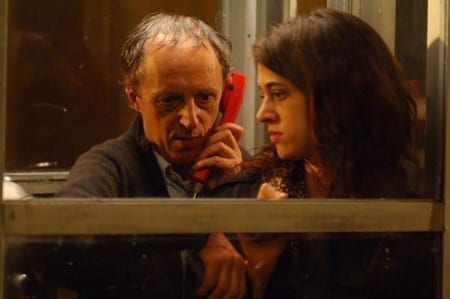
The last time I saw il Maestro was just before the death of the last Pope back in 2005. Rome was languishing in the grip of a greenhouse spring, the skies opening over the eternal city as if heaven itself were sinking and all the angels frantically bailing out to water and somehow stay afloat. The Trevi fountain was not much good for postcards anymore, the Sistine chapel was closed for the duration and the Colliseum, where Cellini had once met that mysteriou Sicillian sorceror, was now a shallow lake.
We snuck into Dario's office early one morning with the collusion of his brother Claudio, giving Mr. Horn the time to light the suite in faux Suspiria primary colors, while I manned the camera and Simon Boswell took care of sound. We were already rolling by the time Dario opened the door and Miss Moor, who was hidden behind him, reached out to place a gloved hand on his shoulder.
It was only the lightest of touches, but when he turned and saw her veiled figure hovering over his shoulder, he gasped, and I'm proud to say we actually got a spontaneous jump out of him on camera. Maybe he thought it was Asia or someone or something else behind that treble veil of crepe, but for a moment, for little more than a second, he looked actually scared. Then Miss Moor laughed and il maestro caught sight of our lens, regaining his composure as he realized he was on the Shadow Theatre equivalent of candid camera.
But for a beat we actually had him!
Later he picked us up from our suite at the Hotel Astrid, the location for The Bird with the Crystal Plumage< and treated us to a lavish multi-course banquet at his favourite bistro. He was officially preparing La Terza Madre<, The Third Mother, or The Mother of Tears, the third and final part of the trilogy, and it was our job to look in and haunt him just a little, to download recent war stories and offer whatever support and encouragement he might have needed.
To this day, I do not feel any would-be reviewer has truly understood the man or his work. His ouvre exists outside the traditional conventions of the genre and have to be approached on their own terms. His critics and supporters rely all too often on the blunt tools of traditional pyschoanalysis, searching for underlying traumas and hinting time and again at their inherent misogyny, yet the glory of Dario's canon is that these pathological impulses were never repressed to begin with. Say what you will of the man, but he was and always will be one of the most painfully, at times embarrassingly, honest filmmakers to have lived and breathed. His psychological dirty linen was openly displayed from the very off, his fears and desires foregrounded for all to see, while something very strange and very different lurked in the background, barely hidden in the wallpaper, literally between the walls and beneath the soles of our shoes requiring audiences and critics to abandon conventional logic and adopt an altogether more Jungian approach.
Tragically, when he finally found a degree of critical recognition in the latter part of his career, it only served to encourage his weaker works while continuing to misunderstand what really made him tick, derriding Inferno and allowing Four Flies on Grey Velvet< to slip into obscurity. While Phantom of the Opera remains widely available, Four Flies was never digitally remastered and remains effectively unavailable on either VHS or DVD - and I don't count the existing fuzzy pirates! If you can't see the look in Mimsy Farmer's eyes as the windscreen explodes in the second last shot in the film, then you're missing the whole point of the damn movie and in every video I've ever come across, her face is reduced to little more than a grey blue blur.
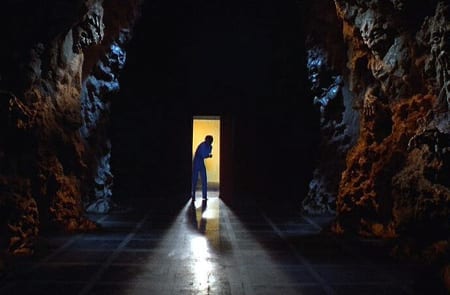
I don't think even Dario himself knows what's really hidden beneath the peeling art deco wallpaper of his unconscious, or how those things quite came together the way they did in his dreams, but like it or not, the man enlarged my mind. While some fans obviously get off on the unhealthier aspects of his material - the violence, misogyny, incest, anorexia and foreground body horror - that was never the point, only the window dressing, the aesthetic superstructure, a magician's trick deliberately misdirecting us from what was really going on.
I was a cynic and an atheist when I first set foot in the Scala cinema all those years ago, and without me even realizing Dario had offered me a way out of the darkness, a key to help me make sense of the world that had been handed down to me. My ex-girlfriend Kate had once lobbed a copy of The Bird with the Crystal Plumage at me, claiming that it was 'Exactly the kind of shit' she 'didn't need' in her life, but I had found more spiritual truth in those lurid, weird-ass, garlic-flavored horror shows than in all the grimoires and holy books I'd ever forced myself to try and read.
For better or worse, they made me what I am today and when all is said and done, I think I've made a pretty decent fist of my life and the limited opportunities available to me. No matter what happens now or what becomes of us, Dario has always been a constant friend, a true ally and the best goddam surrogate father a prodigal son could have hoped to find.
We had all hoped back in the 80's that Mario Bava's son Lamberto might mature to inherit Dario's mantle, and after it became apparent he lacked his vision and tenacity, we looked to Michele Soavi to carry the tradition forward into the new century, but again our hopes were dashed when the budding young director took early retirement to care for his own ailing son. If Mother of Tears was to be not only Argento's swansong, but the death knell for the Italian Gothic as a continuing cinematic tradition, then it made sense for him to take this last chance to make peace with his shattered family and repair the web of time where it had been broken, to bow out with Daria and Asia at his side.
I think we both knew that what he was intending amounted to a kind of career suicide, a grande finale destined to bring the house down. It was a story only he could tell, although I told him everything I could in the hope that he might find something he could use, that some small part of my experience could shed a little light on the Three Mothers' dark domain.
I had only a day earlier been in a tiny Umbrian hamlet named Narni, ostensibly scouting locations for Imago Mortis, an unproduced screenplay taking off on one of the central conceits from Four Flies ('thanatography' - ie: the use of dead people to take pictures, not conventional photographs, but three-dimensional 'thanatographs'), but effectively still pursuing the elusive trail of the Three Mothers.
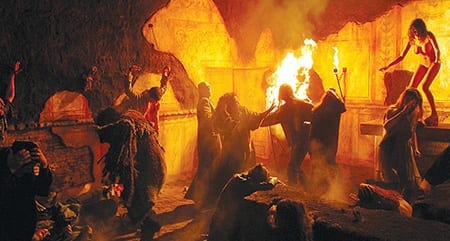
Recent repair work on a damaged aqueduct had revealed an ancient Dominican torture chamber walled up beneath the village streets, its sadistic apparatus and terrifying frescoes hermetically preserved since the dark days of the inquisition and there, on the inner surfaces of the cell doors, I found the graffiti left by the prisoners, the unfortunate heretics who had lived out their final days in that lightlless hellhole, geometric markings already familiar to me from the walls of the Lombrives, including that inevitable telltale arachnid, the sign of the ellusive Tarantula Cult, that had guided me slowly but inevitably back to the very centre of the web, to Rome and the gates of the Vatican itself.
Our conversation that night concerned what lay beneath that square and the current whereabouts of the original meteoric icon, surely indestructable by torch or the ravages of time itself, the Roman Sibyl that had presided over our dreams and seemingly guided our actions from the very off. I had written a lengthy treatment based on the theme from which I draw the title of this blog, Lachrymae, concerning the murder of an American actress during a freak thunderstorm in Saint Peter's Square. A subsequent investigation by the dead girl's twin sister and a hard-boiled but hopelessly conflicted Roman copper uncover not only a pagan sect operating within the walls of the eternal city, but ultimately the existence of the Mother of Tears herself, yet on rereading the final draft, I realized the document said more about myself than it did about my master and accordingly, it remained in the filing cabinet where it belonged.
Il Maestro had started this thing and now it was up to him to end it the way it had begun. Where our thoughts dovetailed will be readily apparent to viewers of this latest, typically troubling and predictably problematic work, yet for now I will say no more of La Terza Madre - The Mother of Tears, nor will I divulge its further secrets, partly out of respect for its auteur but most of all out of the sincere desire that you, the audience, should be allowed to come to it on its own terms and interpret it as you will, with fresh eyes and open minds. If you have taken the trouble to plough through this convoluted, self-censoring blog, then you already know more of the backstory than pretty much any other human being on this planet.
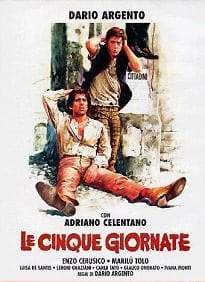 We talked late into the night and il Maestro spoke with eloquence and passion, evidently grateful for the chance to unburden himself and at length, tiring of the subject, he turned to more personal matters, to the wider world beyond our work in the genre, to the long unseen radical anti-authoritarian documentaries of his youth. I had managed to use what limited visibility I had in the genre to place a sampling of my own non-fiction work before the public eye, and Dario couldn't help but wish a little wistfully he could do the same, that he could somehow escape the genre he had made his own and return to his roots, to the shaggy anarchic idealism that motivated his early experiments in cinema, only to lie dormant after the crushing box-office reception of his sole attempt at political satire, his atypical and all but forgotten black comedy The Five Days of Milan<. Although of scant interest to his countless fans, I do not doubt that it is this early documentary work that il maestro ultimately recalls most fondly and considers his most purely personal work. I can only hope that some day he realizes his dream to remaster the material and place it before the wider public.
We talked late into the night and il Maestro spoke with eloquence and passion, evidently grateful for the chance to unburden himself and at length, tiring of the subject, he turned to more personal matters, to the wider world beyond our work in the genre, to the long unseen radical anti-authoritarian documentaries of his youth. I had managed to use what limited visibility I had in the genre to place a sampling of my own non-fiction work before the public eye, and Dario couldn't help but wish a little wistfully he could do the same, that he could somehow escape the genre he had made his own and return to his roots, to the shaggy anarchic idealism that motivated his early experiments in cinema, only to lie dormant after the crushing box-office reception of his sole attempt at political satire, his atypical and all but forgotten black comedy The Five Days of Milan<. Although of scant interest to his countless fans, I do not doubt that it is this early documentary work that il maestro ultimately recalls most fondly and considers his most purely personal work. I can only hope that some day he realizes his dream to remaster the material and place it before the wider public.
He was looking stronger and healthier, filling a little now that he had finally gotten his appetite back and if not entirely at peace with the world, had at least come to terms with his position in it. He was sleeping regularly and deeply and had finally given up smoking, but had he given up on the strange, murderous passions that had made him my maestro to begin with? Even if he had, I could see from the way he bantered with Miss Moor, forcing her to close her eyes while he fed her strips of tripe ('a Roman delicacy') for hors deuves, that he hadn't yet given up on women and no matter how settled he was feeling as an artist, love and its attendant miseries were doubtless still waiting somewhere in the rainstreaked darkness to mug him all over again, and those fearful muses to season his heart with fresh and deeper pains, so that he might once more be accomplished in the furnace and see and convey those things that ought not to be seen by any 'sane' or 'rational' being, sights that are abominable and secrets unutterable.
Elder truths. Fearful truths. Sad truths. Grand truths. Thus is the task of the three mothers, accomplished to plague Man's heart until they have unfolded the capacities of his spirit.
Epilog: The Key to the treasure
That this blog got out of hand is self-evident. I set out to write a celebration of il Maestro's work and the ways it had changed, enlightened and deformed my life. It mushroomed into an esoteric exegesis, and while some mysteries have been clarified and put to bed, others linger like smoke in the air, refusing to be quite so readily dispelled.
No sooner had I put up the first installment of this metatextual footnote to il Maestro's oeuvre than a new and stranger series of events, caused in part by its posting, turned everything I thought I knew about the Rahn affair on its head, forcing a major rethink of the subject matter and engulfing several of this sagas long-term readers in the process.
Since embarking on this shaggy dog story, I have returned twice to Montsegur and found myself back on Rahn's trail with a vengeance, a process only marginally slowed by my own contribution to the mythos of the dark Goddess finally going into pre-production.
After what I can only describe as some of the strangest events of my life, myself and Miss Scarlett, a fellow MySpacer who ended up falling between the lines and getting sucked into the events she was reading about, found ourselves back in the sleepy hamlet of Rennes les Chateau.
Since my last visit, the one restaurant in town, the 'Blue Apple' had been mysteriously burned to the ground and the shadowy 'Association' had taken control of the domain and forced Marcel to give up the cherished keys to the church. Celia took it all in her stride having bigger fish to fry. She had married Marcel and was pursuing her claim to the throne of Sarawak with some success. For the first time, she had begun to consider moving away from the plateau and dreamed of an airy long house somewhere in the tropics, where she might live out her days surrounded by her beloved Dayaks. Dagobert, the mountain dog, had sadly passed while Grace had moved to Paris and was a mother herself now, her son, Leandro, apparently named after the Telly Savalas character from 'Lisa and the Devil'. Given his heritage, I suspect he has a long and interesting life before him. The right-wing mayor is sadly still very much in charge of the town, although his attempts to enforce some kind of order have thankfully made little headway against the demented status quo.
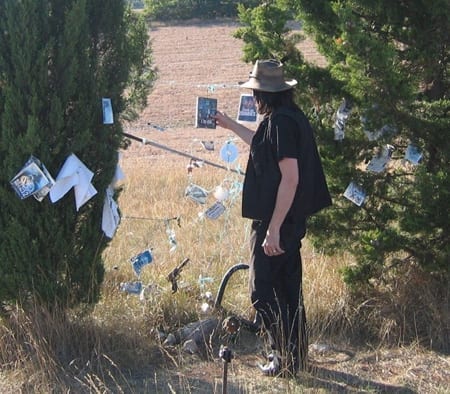
In the Zone - August 2007
Amateur treasure hunters still chip away at the church's leaky foundations and Danielle is still wearing a dress and massproduces ever more detailed and complex treasure maps, having developed a winning passion for cutting and pasting the covers of Italian horror DVDs and leaving them hanging from surrounding trees and fences as helpful clues to the initiated and warnings to the unwary.
Danielle's work has been getting more and more detailed over the years, but the appearance of the Italian horror material is a recent development. I suppose its reassuring to know that at least one other person out there seems to have figured out that the real problem with Rennes is that the town is built over one of Fulci's 'seven dreaded gateways.'
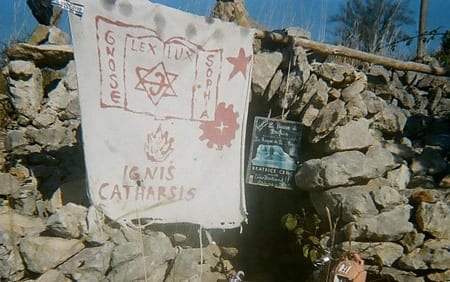
The exqusite choice of titles indicates that not only does Danielle have a thorough working knowledge of the genre, but considerable insight into the deep history of the area. The copy of Fulci's Beatrice Cenci<, under its French release title The Passion of Beatrice, is a 'metatextual' gag par excellence... Beatrice, of course, accompanied Dante during his journey to Hell, where among other sinners, he encounters his own mentor, Guido Cavalcanti, who had been responsible for initiating the young poet into a heretical secret society known as the 'Brotherhood of the Faithful in Love', which traced its lineage back to the Nicetas himself, widely seen as the founding father of the so-called 'cathar' faith...
Dante studied the lost tongue of the vanquished nation (Romans) and seems to have coined the term 'Lingua Occitania' in his treatise De Vulgai Eloquentia in 1305, from whence we draw our name for what is now the southern most province of modern France - the Languedoc. In its original usage 'Oc' was simply 'Yes' in Romans, the equivalent of 'Oui' or 'Si', and the origin of the modern Anglo-Saxon use of 'okay' as an affirmative particle...
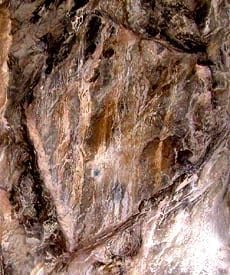 All of which connects on more levels that I have time to explain. 'Coincidence' perhaps, but I stumbled across the shrine to Beatrice Cenci on the same day that we had gotten back from Ussat and a closer inspection of the natural stone pentagram in the Bethlehem Grotto closely associated with the continuing Rahn enigma. The outlines of a face are still faintly visible beneath the dust on the cave wall, allegedly the 'face of Beatrice', and needless to say, the shallow octagonal depression is rumored to be a 'gateway' of sorts...
All of which connects on more levels that I have time to explain. 'Coincidence' perhaps, but I stumbled across the shrine to Beatrice Cenci on the same day that we had gotten back from Ussat and a closer inspection of the natural stone pentagram in the Bethlehem Grotto closely associated with the continuing Rahn enigma. The outlines of a face are still faintly visible beneath the dust on the cave wall, allegedly the 'face of Beatrice', and needless to say, the shallow octagonal depression is rumored to be a 'gateway' of sorts...
The Bethlehem Grotto is so-named because of a natural shaft in the rock, that causes a beam of light to fall on the ancient stone altar before the pentagram on just one day of the year - the 25th December. Members of Gadal's neo-cathar Rosicrucian movement undergo a three-year period of study, meditation, indoctrination, fasting and general reprogramming before undergoing their final initiation in the pentagram, possibly in the presence of the 'Pyrenean Grail', which, I believe, may be in the movements hands. Since the making of The Secret Glory, the grotto has been haphazardly fenced off by the neo-Cathars, destroying much of the site's natural beauty. Behind locked steel gates excavations continue in secret, yielding a steady trickle of fascinating, often contradictory artefacts.
I was looking for divinity, yet I find myself at the gates of Hell. Still I may continue to walk, to fall, even in flames. If there exists a way towards Heaven then it crosses Hell. At least it does for me. Well then... I dare!
- SS Obersturmfuhrer Otto Wilhelm Rahn
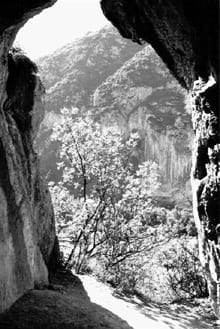 I labored for some years to pitch a TV sitcom based on the Rennes area and its inhabitants - a format I felt richly suited to the 'cat-in-the-hatty' material - an esoteric hybrid of two British war horses Crossroads< and 'Allo 'Allo!<, set largely in the foyer of the titular Seven Doors Hotel, which happens to be built over... well, you can guess that part! A recurring character based on Danielle figured heavily in the treatment alongside a motley assortment of thinly disguised Rennes survivors. While the thought of slamming out a couple of low-rent seasons tickled my funny bone, the concept failed to raise any smiles from the powers that be and subsequently remained on the drawing board.
I labored for some years to pitch a TV sitcom based on the Rennes area and its inhabitants - a format I felt richly suited to the 'cat-in-the-hatty' material - an esoteric hybrid of two British war horses Crossroads< and 'Allo 'Allo!<, set largely in the foyer of the titular Seven Doors Hotel, which happens to be built over... well, you can guess that part! A recurring character based on Danielle figured heavily in the treatment alongside a motley assortment of thinly disguised Rennes survivors. While the thought of slamming out a couple of low-rent seasons tickled my funny bone, the concept failed to raise any smiles from the powers that be and subsequently remained on the drawing board.
It's never been easy to actively profit from the mystery, as Michael Baigent and Richard Leigh found out when they lost their shirts trying to sue Dan Brown in London's high court over alleged 'similarities' between the Da Vinci Code and their one time 'groundbreaking' bestseller The Holy Blood and the Holy Grail, effectively admitting that the whole Sangraal/ Sacred Bloodline was more or less fictional, if not wholly their creation to begin with. Henry Lincoln wisely stayed clear of the legal fallout and still lives in the region of Rennes les Bains, where he ekes a stipend conducting esoteric guided tours for lazy conspiracy theorists, who can't be bothered to come up with a hypothesis of their own.
Regaining undisputed sway over the Domaine certainly doesn't seem to have done Claire Corbu or Antoine much good. I finally succeeded in getting them around the dinner table, but being Ascension Day, all the shops were shut and I was forced to turn to our old friend the Sufi Sheik for help with the ingredients. The Sheik's conviction that he could halt the growth of the cancer cells in his body by injecting ketamine into what he believed to be the tumours would seem to have been borne out, and he is still happily alive and kicking, albeit just a li'l confused about his current identity, having hacked apart the Mettarie door with his Templar Sword so many times during a recent spate of violent 'past life-related episodes', that the local handymen now refuse to take his calls, leaving security at the house on the hill a little wanting.
A deep-frozen experimental Manta Ray scavenged from the former neurochemists freezer, however, provided an adequate main course, fleshed out with local fruit and veg, a cheese selection and the Black Forest gateau we'd saved for the occasion, complete with the requisite chocolate sprinkles. All in all, it slipped down nicely, despite the uneasy, conflicted allegiances of the assembled guests.
Relieved of his formal duties in the graveyard, Marcel had not only found the time to completely redraw his graphic account of the plateau's history, this time boldly filling in the missing details, but had even found a new publisher willing to take on the poisoned chalice. As aforementioned, no one has ever really succeeded in making a dime from the Rennes mystery without losing their lives or their sanity, apart from Dan Brown anyhow, but considering the enigmas track record, I wouldn't rate his chances in the long run. Celia has recently completed a book of her own, her long awaited autobiography Muda Dayang, that I think will come as a true revelation to long-term mystery watchers.
After twenty years of foreplay, it came as something of a disappointment when Celia and Marcel finally dropped the other shoe and simply told us what was really going on. Doubtless their account will be hotly disputed and inevitably overlooked in favor of countless more fanciful, more inherently dramatic theories. It's an old story and a simple one. There are a million other stories just like it drifting through the zone, but I think you will find on further investigation it fits the known facts too snugly to be anything other than the truth.
And it goes like this -
The coded documents found by Antoine and Marcel's granddad in the hollow altar column were written in the 1780's by one of Sauniere's shifty predecessors, the Abbe Antoine Bigou. Among his duties as local priest, Bigou acted as chaplain and confessor to the noble Blanchefort family, who had counted at least one former Templar Grand Master among its illustrious forebears. They were amongst the richest landowners in the area and fearing they would lose everything at the time of the French Revolution, conspired with Bigou to hide their heirlooms and undeclared collateral in the family vault and the catacombs beneath the church itself, where they assumed it would survive the attentions of the rapacious, albeit superstitious Catholic serfs, who had forced the noble line into what they had initially assumed to be temporary exile.
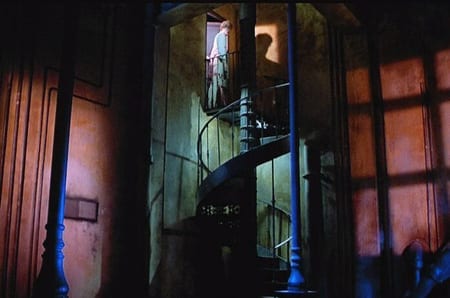
With Boudet's help, Sauniere succeeded in partly decoding Bigou's cipher, only to find that subterranean waters rising from the cavity beneath the plateau had caused subsidence in the ancient vault that communicates with the chapel via that narrow stone staircase I first glimpsed all those years ago.
Realizing it would be harder work than he thought, Sauniere was forced to recruit Marie Denarnaud's help and with her aid, they succeeded in retrieving and frittering away a good part of the Blanchefort family's lost fortune.
A continuing suspicion lingers in the area that some part of the hoard still remains hidden in the increasingly unstable foundations, and having gained full and unfettered access to the site in the early 90's, Celia and Marcel had set about the laborious task of pumping out the flooded vaults, only to eventually reach the conclusion that there was nothing left to find. They had since lost control of the Domaine to the 'Association', who were now saddled with a rickety old building with rising damp.
"That's it, huh?"
"Looks that way."
Miss Scarlett shook her head as we bade our hosts farewell and headed for our waiting hire car.
"It's just... I dunno... a little disappointing, I guess. Too Scooby Doo..."
"So what were you expecting? Like, a space-time portal to beyond infinity would have been great but hardly likely. Ditto the Ark of the Covenant. And that bloodline thing. Human greed is something I can believe in."
"What about those bodies they found in the flowerbed? Who killed them?"
"Collateral damage. I dunno. What does it matter anyhow? It obviously wasn't aliens or little people."
"And that flashlight..."
"What flashlight?"
It was just after three in the morning and the plateau was dark and still, the outline of the Tour Magdala rising before us in the starlight, the windows of the Villa Bethany blind and silent.
"That flashlight you mentioned in the last blog. Y'know - the one you found in the cave."
"What about it?"

I froze, sensing a stirring in the shadows at the base of the tower.
"You ever get around to measuring those bite marks?"
"There's something moving down there!"
"I know!"
A scuffling, sliding sound came from out of the dark followed by the unmistakable sound of trickling pebbles.
"The hell is that?"
"Sounds like more than one!"
We stood squinting into the blackness.
"Probably just some deranged treasure hunter having a go at the foundations or Danielle hanging out more Fulci titles to scare the tourists."
"It's not human."
"Oh, c'mon..."
"But it's not. Listen..."
There was a crackle of snapping twigs as one of the prowling shapes cut across the dry brush towards us.
"This place has no cryptozoological history whatsoever. It's not supposed to have a monster..."
"Maybe we should head before we find out."
"It's cool. I've got just the thing. It's never going to be expecting this!"
Slipping the Arctic floodlamp I had purchased in Akuriri for the previous seasons fact-finding excursion to northern Iceland, I flipped it onto full flood, bathing the base of the Tour Magdala in sudden violent wattage. But it didn't seem to surprise whatever was out there or even slow it down.
"The ***k?"
I narrowed my eyes, deciding that it probably wasn't human after all.
"Let's just go, okay?"
Brandishing the floodlamp defensively I started back across the parking lot to the car.
Big bugger. Some of 'em striations have gotta be at least three inches...
+++++++++++++++ TRANSMISSION ENDS
- Войдите или зарегистрируйтесь, чтобы получить возможность отправлять комментарии
Similar By Terms
|
(English)
|
(Español)
|
(English)
|
(Deutsch)
|
|
(Русский)
|
(Русский)
|
(English)
|
(English)
|







Последние комментарии
13 лет 38 недель назад
13 лет 39 недель назад
13 лет 39 недель назад
13 лет 39 недель назад
13 лет 42 недели назад
13 лет 48 недель назад